1lumen selects and reviews products personally. We may earn affiliate commissions through our links, which help support our testing.
Lumintop Thanos 23 review
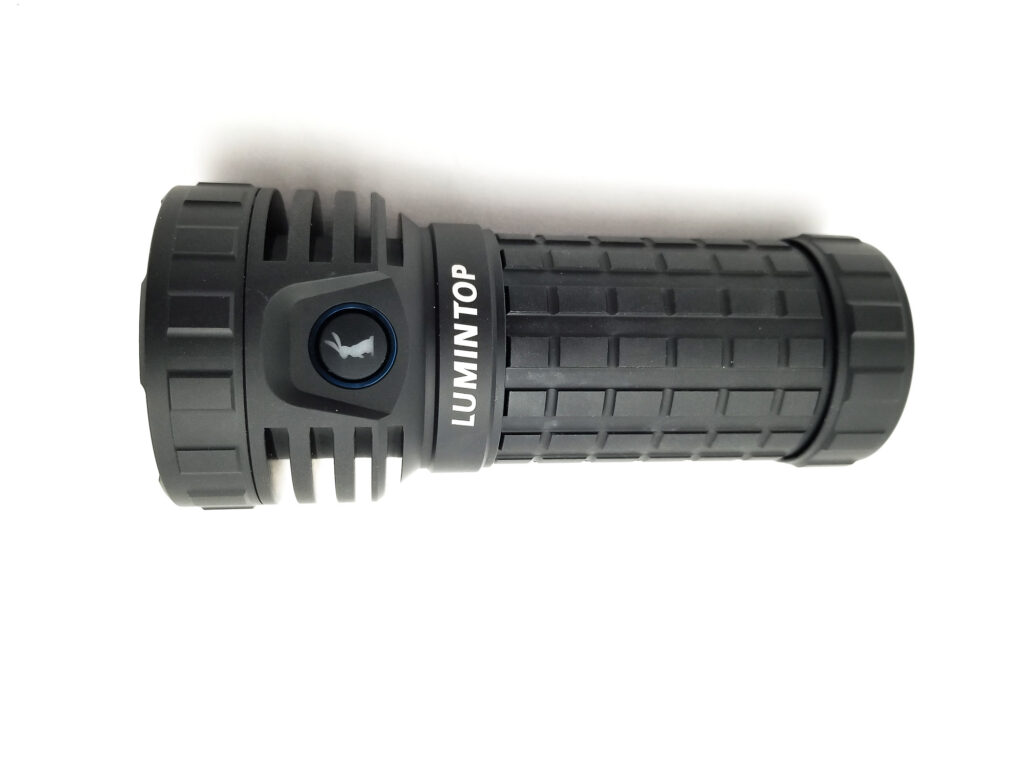
Lumintop Thanos 23 specs
| Brand & Model | Lumintop Thanos 23 |
|---|---|
| Flashlight category | Lumenmonster |
| LED | 8*Cree XHP50.2 HD, 1*Luminus SFT-40-W |
| Max. output | 27,000 lumens max (spot+flood) |
| Max. beam distance | 700 meters max (spot+flood) |
| Max. beam intensity | 125,00 cd max (spot+flood) |
| Battery config. | 3 * 21700 |
| Onboard charging | USB type C with Power Bank |
| Main modes | 5 |
| Blinkies | Strobe, SOS, Beacon |
| Waterproof | IP68 |
| Review publication date | August 2023 |
Review intro:
Today we’ll be taking a look at a new light from Lumintop, the Thanos 23. To be fair, this is the first flashlight I’ve run across that’s named after a comic book character (I’ll leave the potential copyright infringement fight to Lumintop and Marvel’s legal teams). but I almost had to pinch myself since this thing looks almost identical to the other high output soda can light from Lumintop I just reviewed, the Lumintop Mach. The Thanos 23 is not the Mach though, and incorporates more clever platform-sharing and packaging. In fact, a lot of the Mach is present here, from the bottom of the battery tube to the bezel. This one retains the 8 XHP50.2 HD LEDs, but the fan has been swapped for a reflector and a throwy LED. The UI is also a bit different and more conventional. Oh, and the high output is also present (up a hair from the Mach actually). Since the Thanos and Mach have a lot in common, some of the Mach review may pop up here. Let’s take a look!
Package quality.
The Thanos 23 came in a non-retailable, utilitarian box with a lift-off lid and specs. It’s identical to the Mach’s. Not too much fanfare. Inside, it’s about what I was expecting from Lumintop.
- Lumintop Thanos 23 flashlight
- Screw-in swivel stud
- Manual
- USB type C cable
There’s not much here, just the bare necessities. The light doesn’t include batteries, but you can get them separately. My review light came with 3, Lumintop branded button top 5000 mAh 21700s, provided by Flashlight Go.I don’t know who makes these, but still, I highly recommend getting the kit with batteries, since you’ll need button tops, and batteries which can provide at least 25-30 amps of continuous discharge.
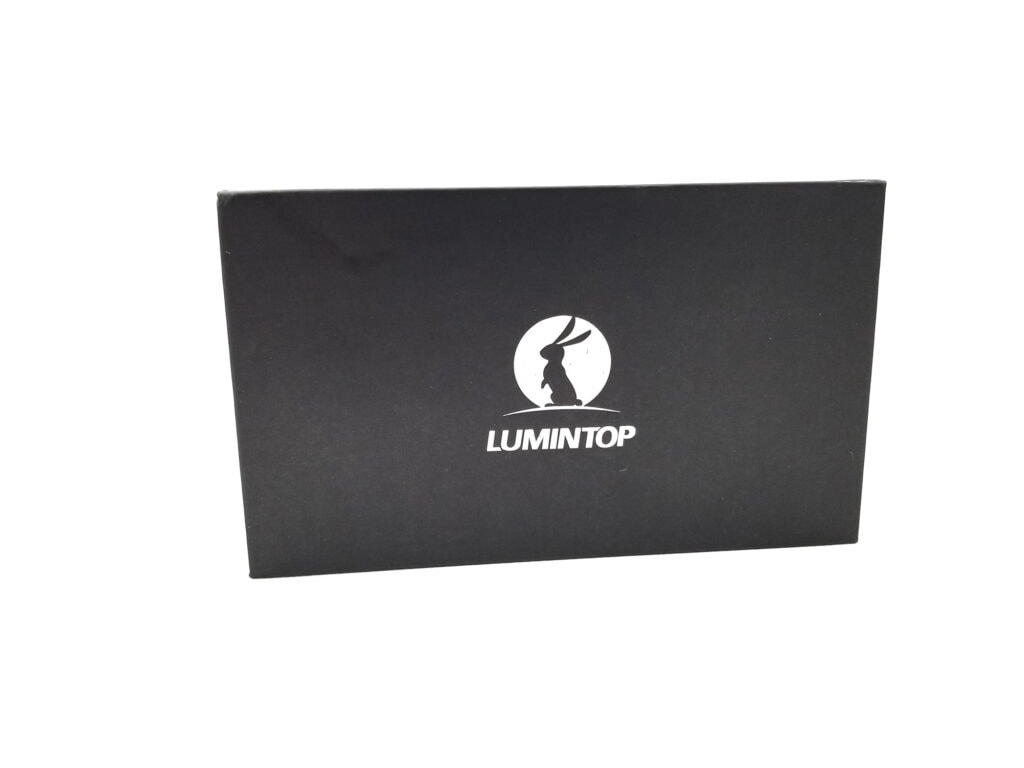
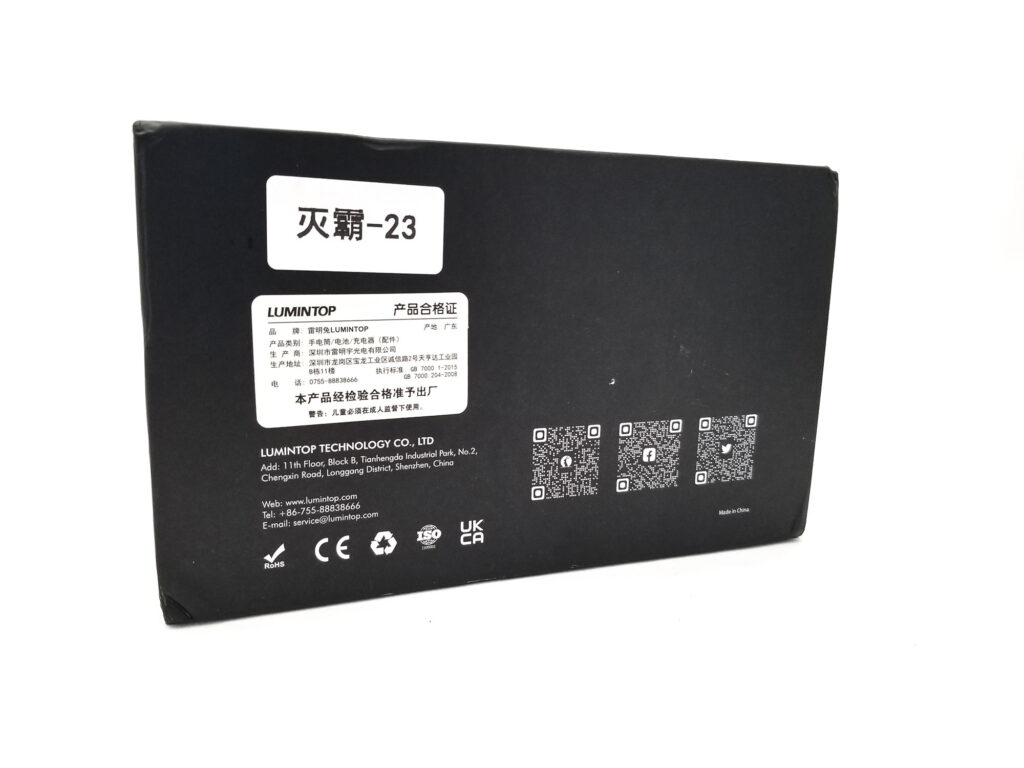
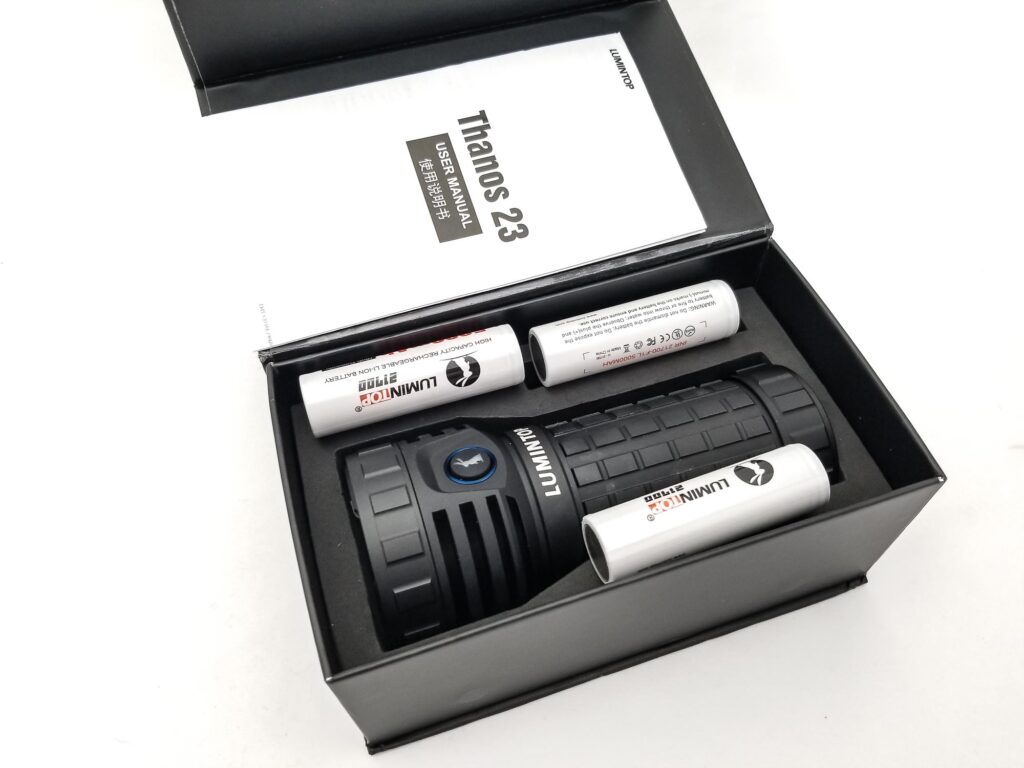
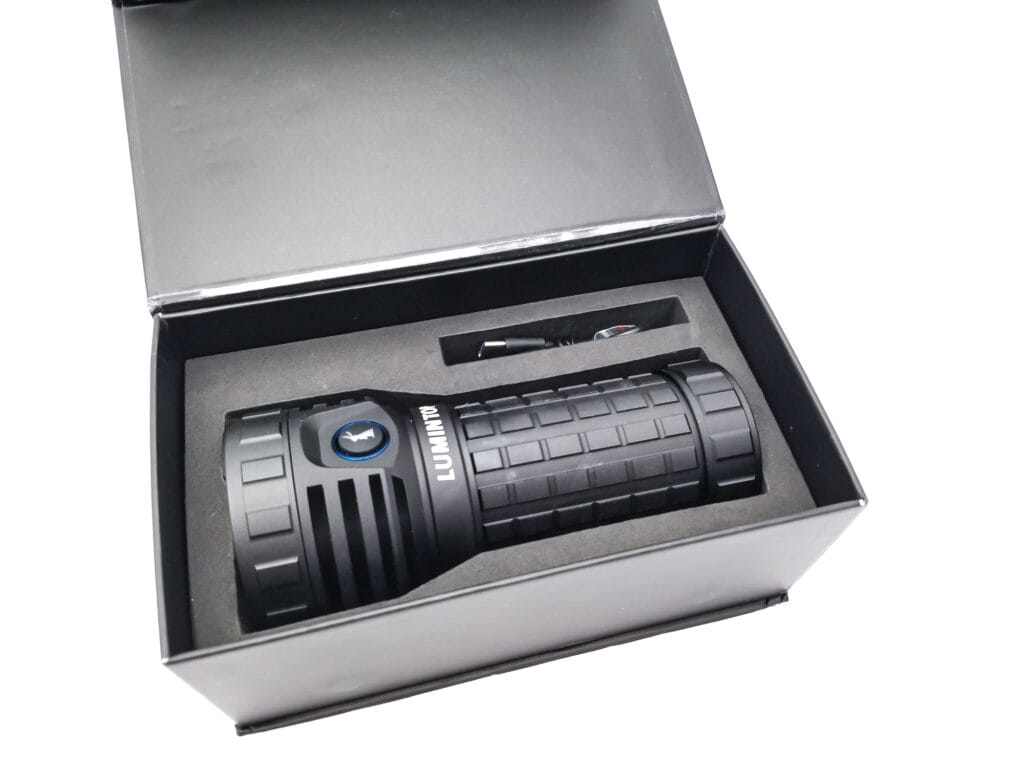
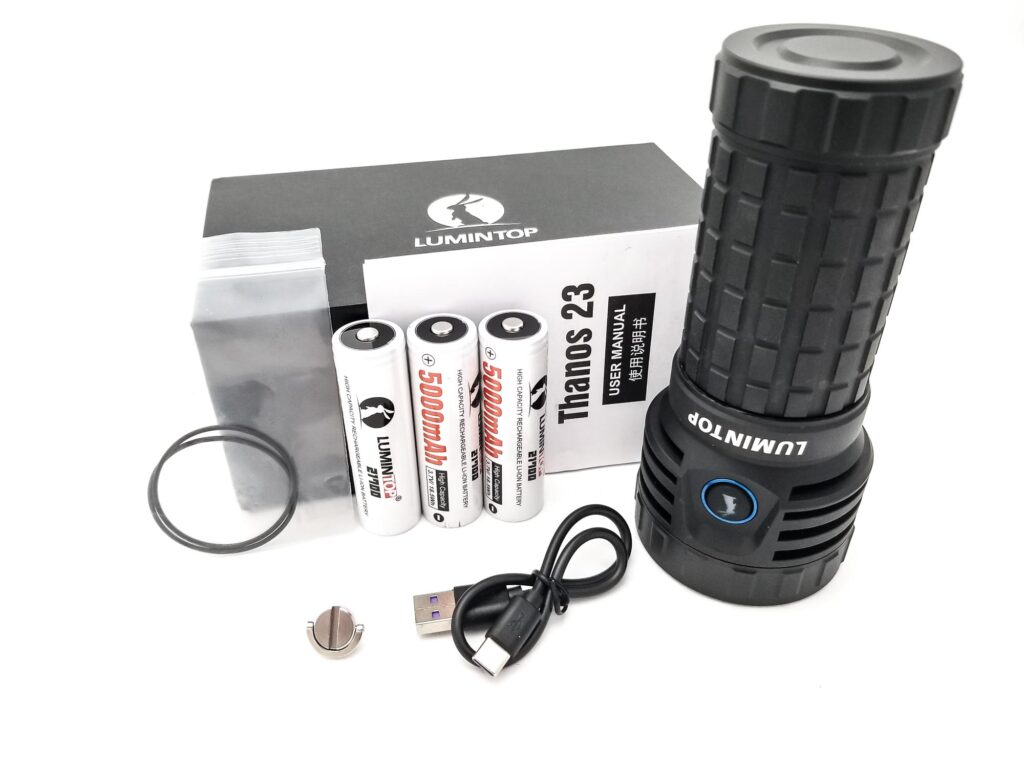
Flashlight in use
The Lumintop Thanos 23 is a high output general purpose flashlight. It can make a lot of light and spread it out over a large area, but can also throw pretty far thanks to the spotlight LED. These types of lights are usually sporting multiple batteries, so that makes them bulky, and heavy. Pocket carry is out of the question. The Thanos 23 is going to be best toted around in a holster or dangling from a lanyard (neither of which are included). Lumintop does include a screw-in stud with a swiveling bail that threads into a ¼ x 20 threaded mount on the backside of the head opposite the switch. This would also be an attachment point for a tripod shoe.
The battery tube is properly girthy, and folks with smaller hands might find it a handful. The body has a lot of squares with abrupt edges that really aids in gripping. The tailcap has nice polygonal gripping surfaces, and so does the bezel. I’d say every bit as good as traditional knurling. For a big light, it’s pretty maneuverable, but make no mistake; this isn’t an EDC piece, and probably does best riding in a holster.
Switching duties are handled by a single e-switch aft of the head. The rubber button has a translucent part shaped like the Lumintop bunny with LEDs behind it for on state, lighting mode selection, charge status and LVP. It’s set in a snazzy blue anodized aluminum bezel. The switch action isn’t as snappy as some others, but it’s still tactile and audible and the button feels pretty nice. Tail standing is super stable thanks to the very wide, flat tail, perfect for area lighting.
Like the Mach, and Lumintop Thor Pro, there’s no external charge port. The charging input and powerbank outputs are concealed under the tailcap. Unscrewing it reveals an I/O panel with a segmented LED display, momentary switch, USB type C, and type A sockets for charging input and power bank output. It’s designed so that you don’t have to remove the batteries except to replace them. I really like this concept, since it guarantees water intrusions are going to be minimized, plus you can swap out the batteries if needed. This is becoming less common these days on the big, high output lights from the bigger manufacturers, so thanks Lumintop!
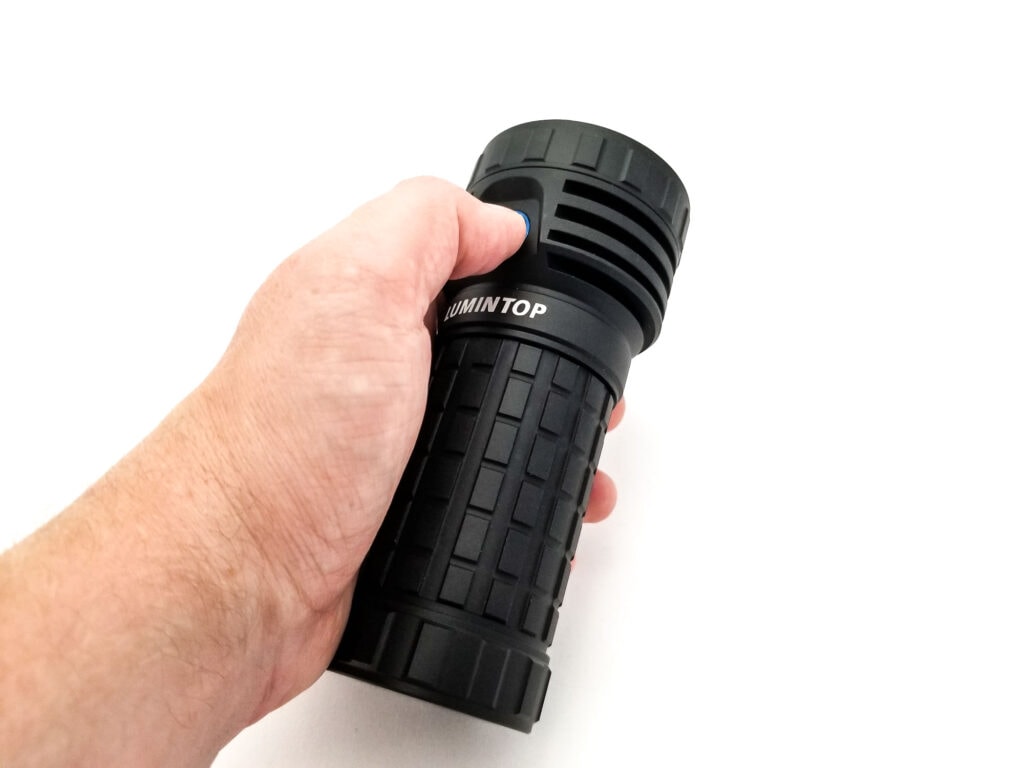
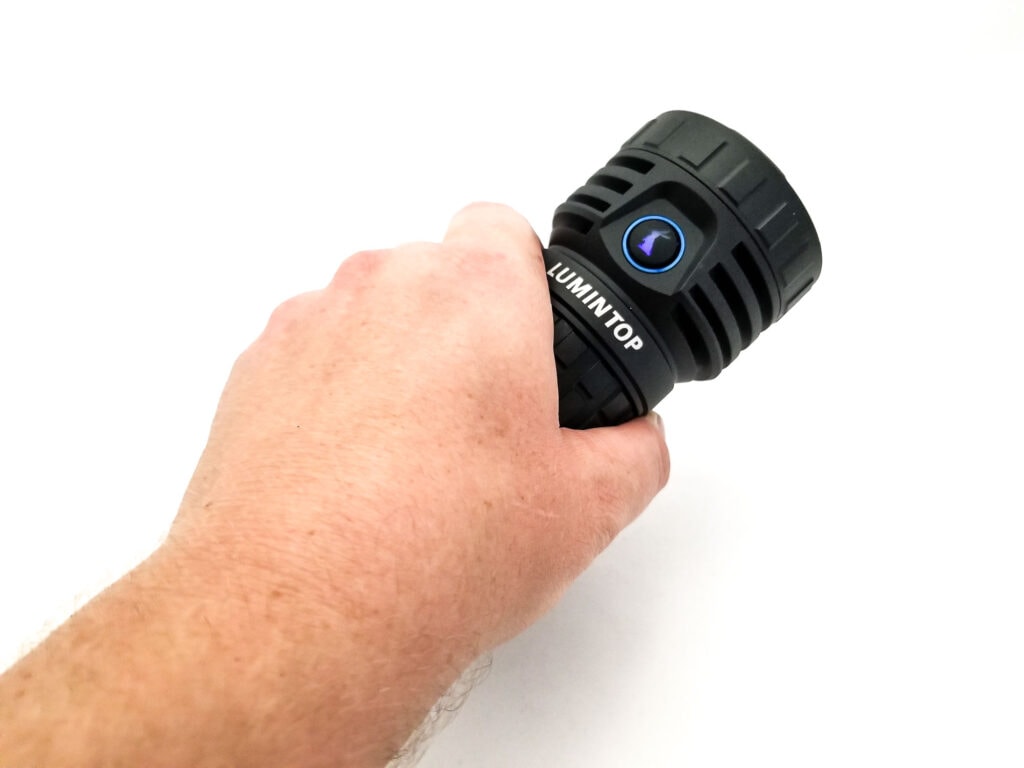
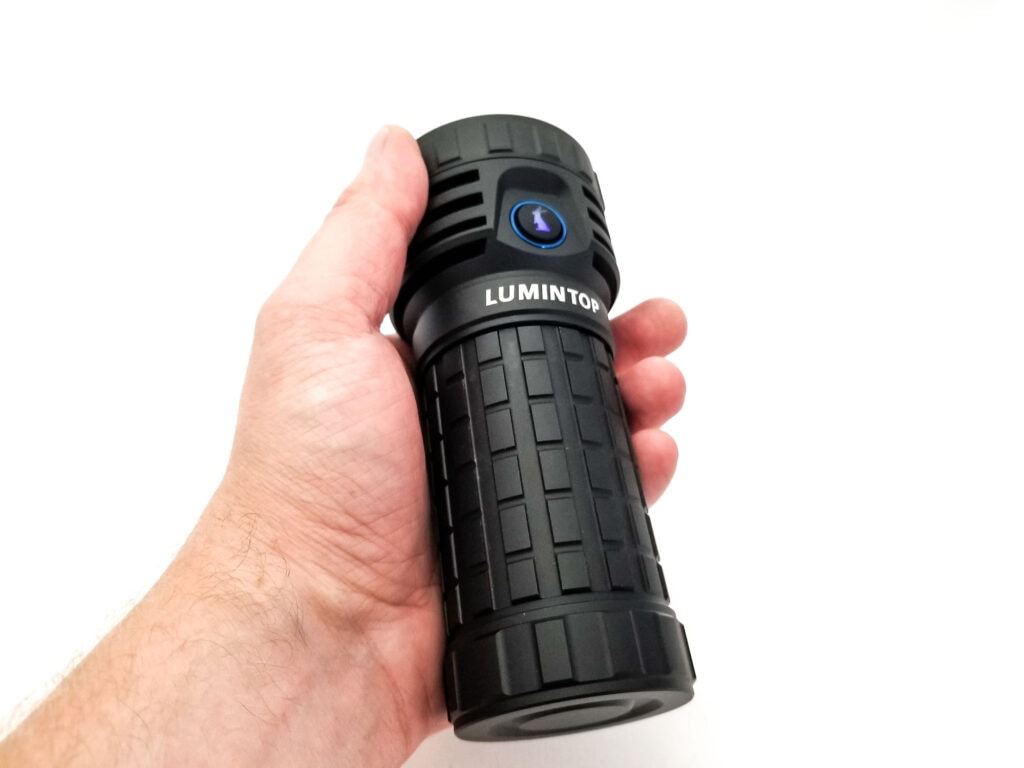
Build Quality and Warranty
The Thanos 23 carries over the typical Lumintop build quality. Overall, it’s nice and tidy, and I think befitting of the asking price, which is right around $200-$250 depending on discounts, but the MSRP is high at nearly $270 US. I think that’s a fair price for what you get. The light is milled from 6061-T6 aerospace aluminum and the machining is really tidy and defect-free. There weren’t any tooling marks or blemishes, and sharp edges weren’t present (aside from the gripping surfaces on the battery tube). All the parts fit up perfectly with no odd gaps or misaligned parts, and I expect that at this price.
The finish? I really like it! It’s available in any color you want as long as it’s black, and the finish is advertised as type III HA hard anodized. It’s pretty grippy, and after photographing and other things, there’s already some wear. The threads all around are fully anodized and pretty thick. There wasn’t too much lube on them out of the box, but they were smooth nonetheless. Still, I’d add some synthetic grease. Everything’s o-ring sealed: The front of the battery tube, charge I/O access cover (aka tailcap), bezel, lens.
The springs in the bottom of the battery tube are very substantial and non magnetic copper alloy for maximum current handling. The driver has brass contact rings for the positive and the ground plane. The tube also has a gold-plated pogo pin sticking out of the top that interfaces with another ring on the back of the driver, probably for the charging function. Luminto gives the Thanos an IP68 rating. With no external charge port, I believe it.
Warranty? Contact Flashlight Go if you buy it through our link, in case you need help.
From Lumintop: Lumintop warrants our flashlights to be free from defects in workmanship and materials, including any LEDs housed within, for the lifetime of the original owner. 30-day free replacement: LUMINTOP will replace a new product within 30 days of purchase for any manufacturing defects if problems come into being in normal use; We will replace it with the same model. If the model has been discontinued, customers will receive a product with a similar or improved model. Five-years free repairs: LUMINTOP will offer free repair within 60 months for lights from the date of purchase if the problem develops with normal use. Lifetime warranty: If repair is required after guaranty period, we’ll charge for parts accordingly.

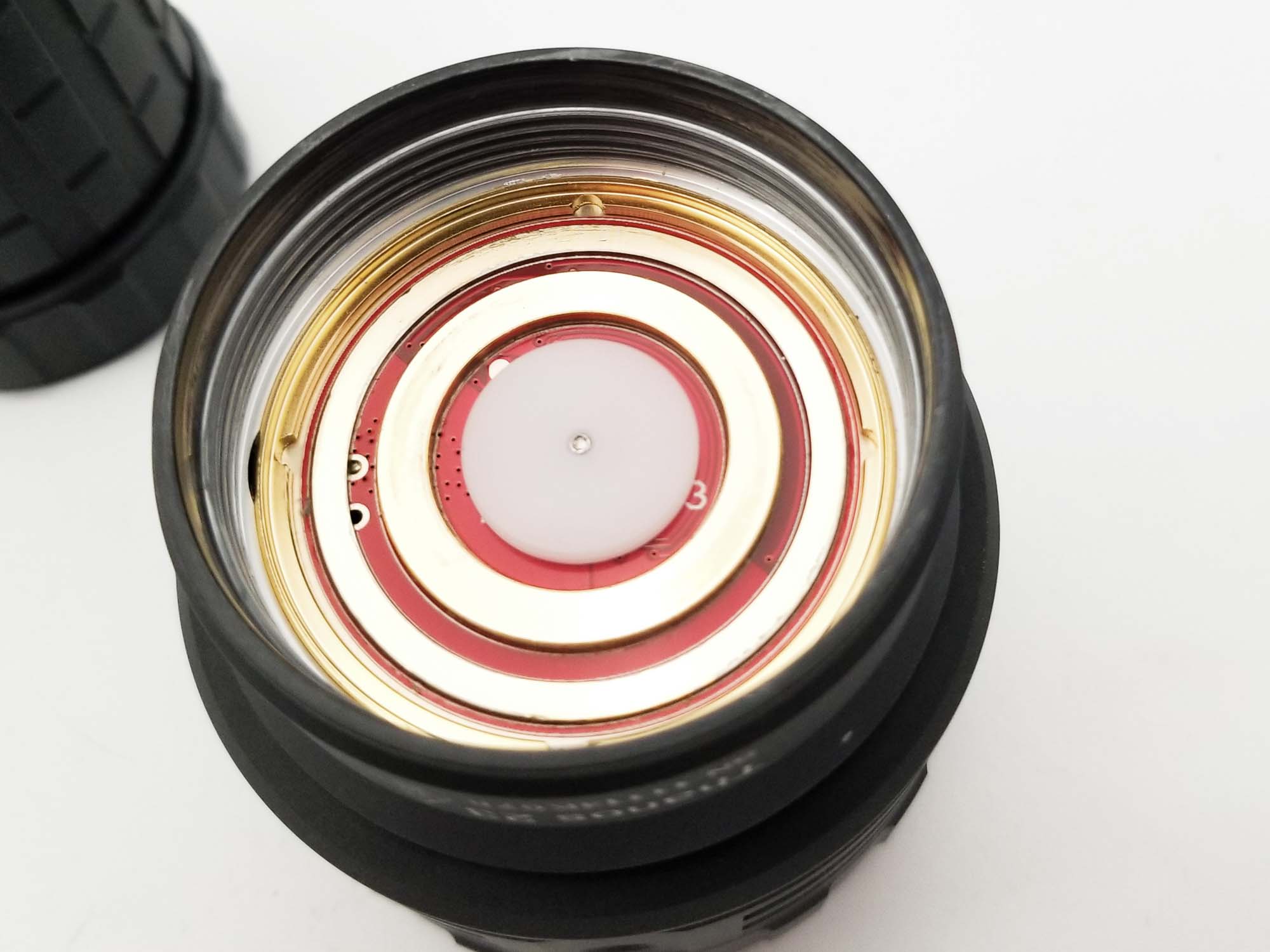
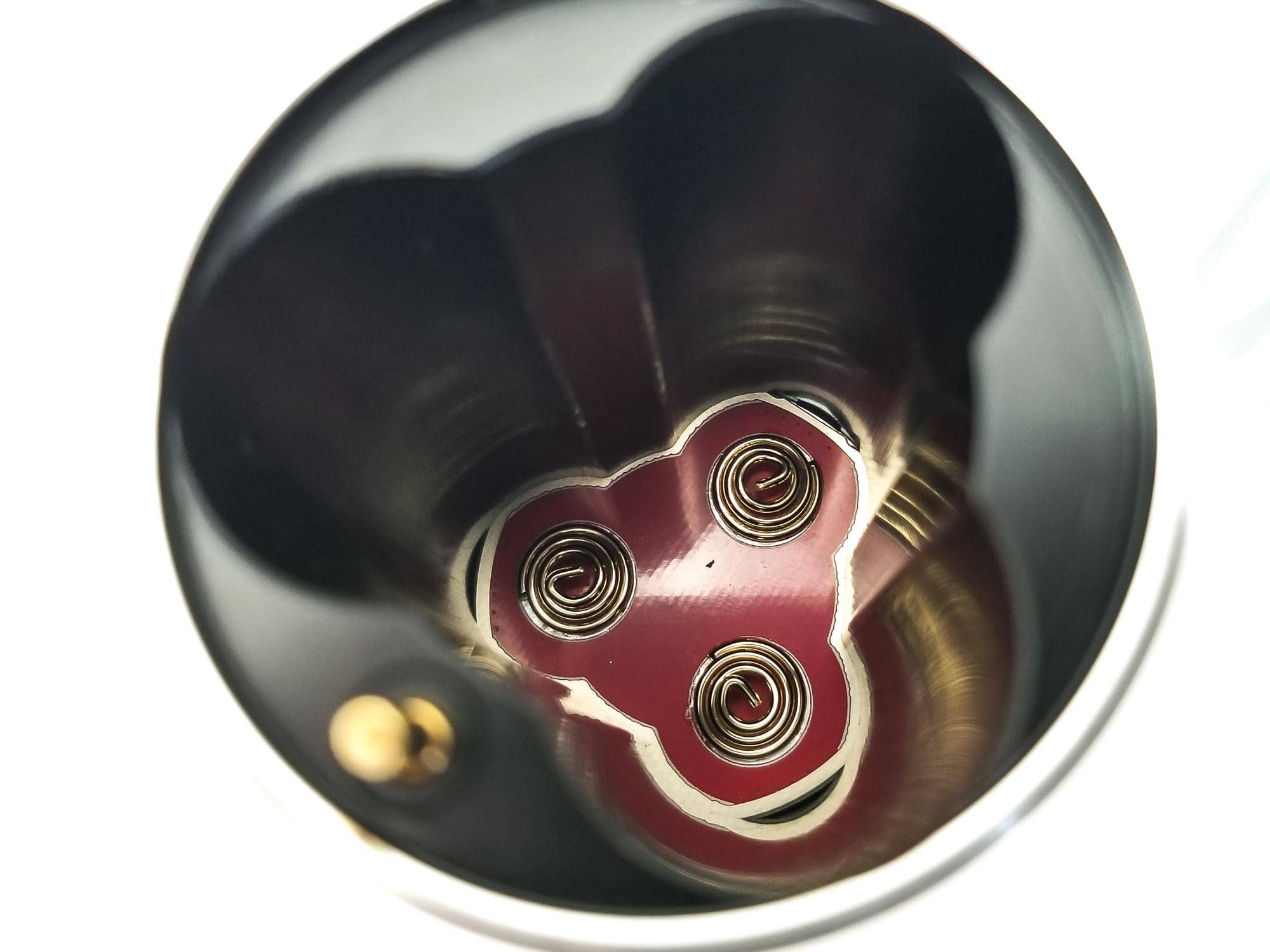
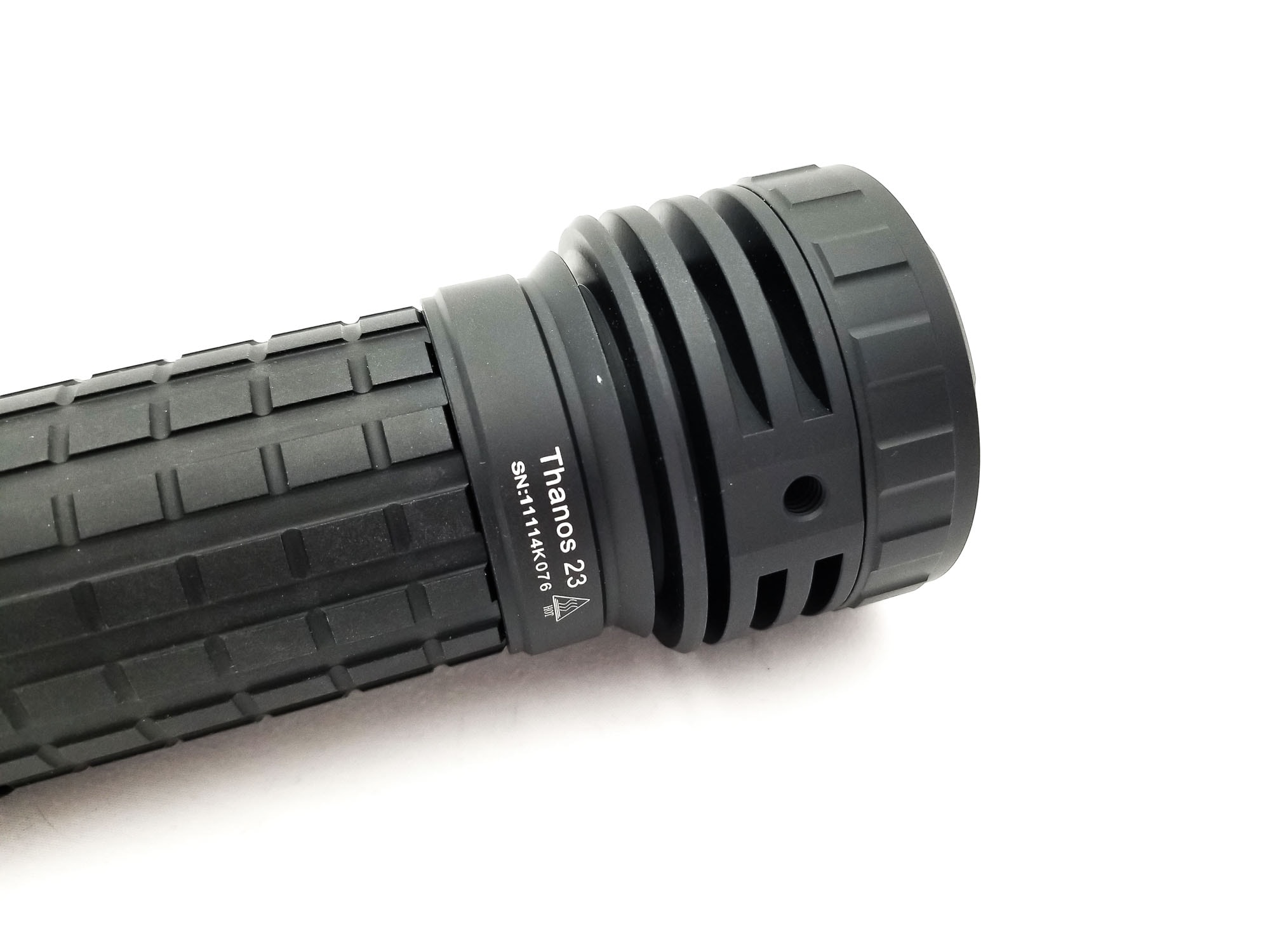
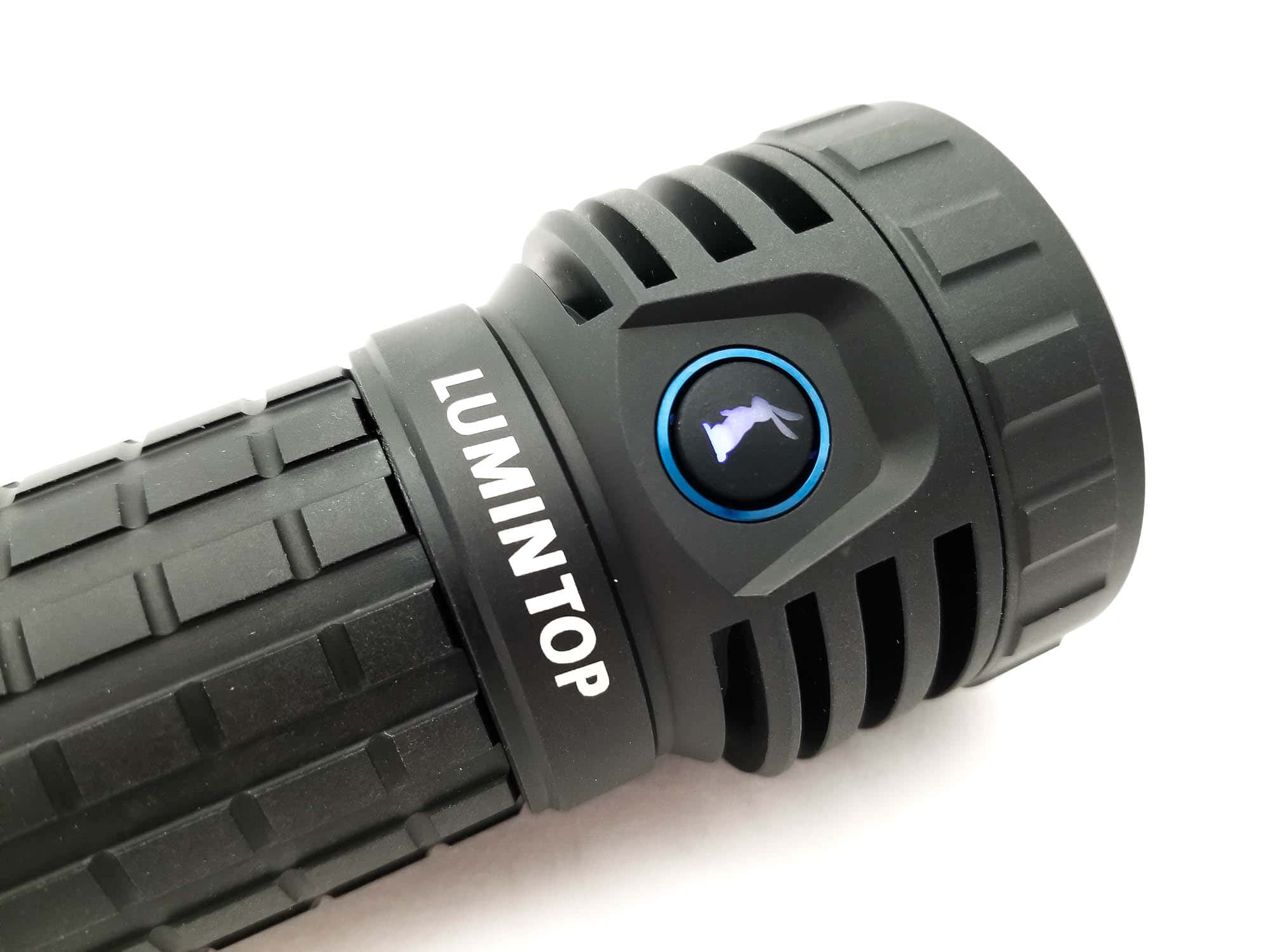
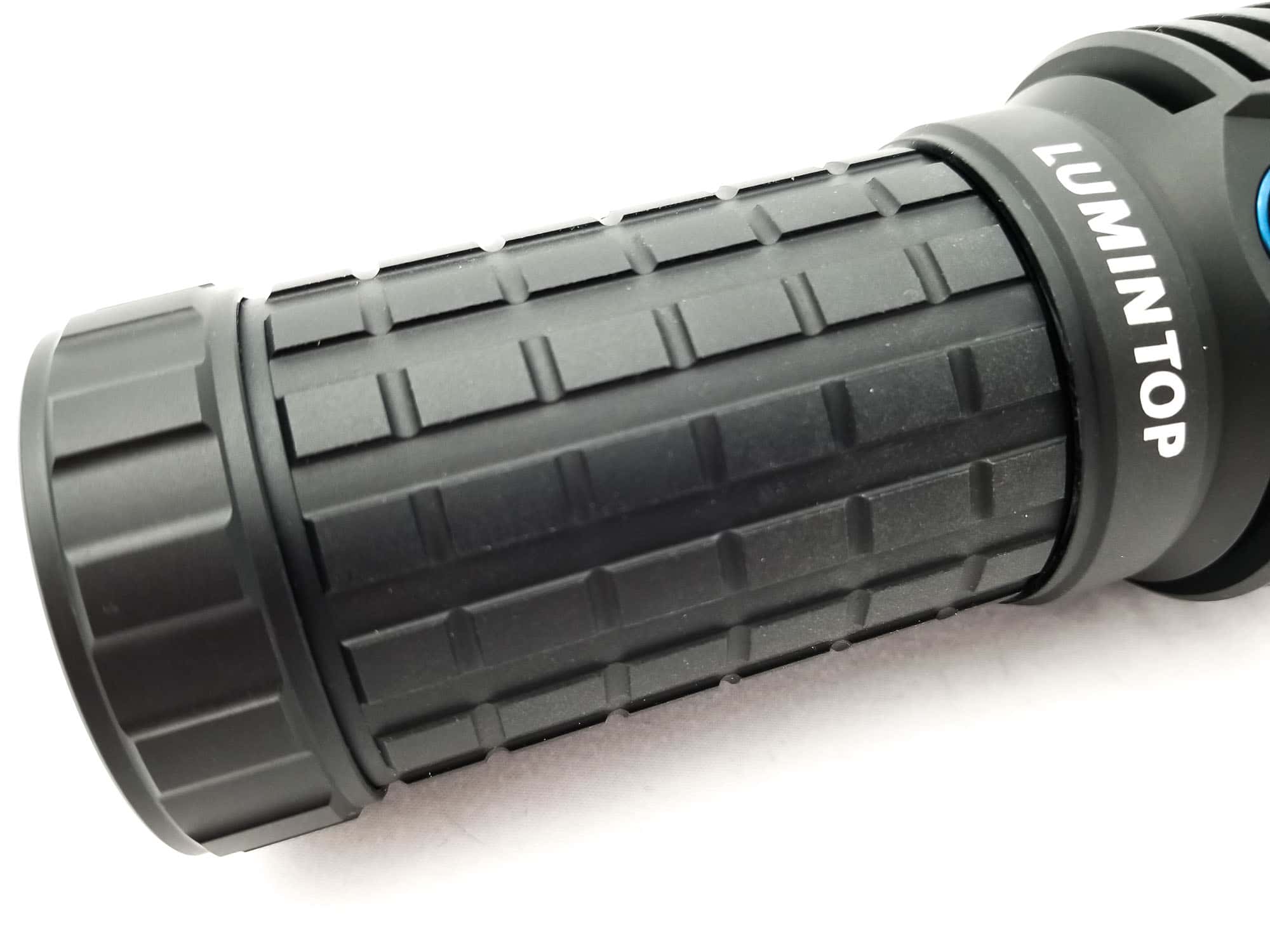
LED, Lens, Bezel, Beam, and Reflector
Like the Mach, the Thanos fields 8* XHP50.2 LEDs for the light show for the flood, and a Luminus SFT-40-W supplies the throwiness. The XHP50.2 is a quad-die 5050-size LED and can be had in either 3v, 6v, or 12v configuration, in HD (domed), and HI (domeless). It’s a CSP design so it can be driven pretty hard without popping, and it’s pretty efficient across the CW bins with a low thermal resistance. These ones are listed as cool white. The downside of these LEDs is (like all gen 2 Cree products), is they suffer from angular tint shift and a generally ugly beam with a pee yellow corona and a bright hotspot.
On the throw side, the SFT-40-W really needs no introduction, but it’s a domeless 5050-size 3 volt LED. This one is perfectly centered in a centrally-located deep cup SMO reflector. The bezel is aluminum and the lens is recessed a bit for drop protection.
The XHP50.2s are arranged in a circular pattern in 8 individual orange peel reflectors. They’re about 11 mm in diameter and fairly shallow. It’s topped with a piece of AR coated mineral glass.
The flood beam has a nearly indiscernible hotspot surrounded by lots of spill. It really is a wall of light, similar to the Thrunite TN50 and Wurkkos TS32. Like the TS32, the throw LED produces a tight hotspot with bright spill that has great distance/reach. It’s not a pencil-thin beam. The Opple Lightmaster Pro has the XHP50.2s (on Turbo 1 meter from the sensor) coming in at 6212K and CRI Ra of 68.9. The duv is 0.0018, so close to the BBL. The Luminus is coming in at 6302K and CRI Ra of 66.1. The duv is 0.0078, so more green as I expect from CW Luminus products.
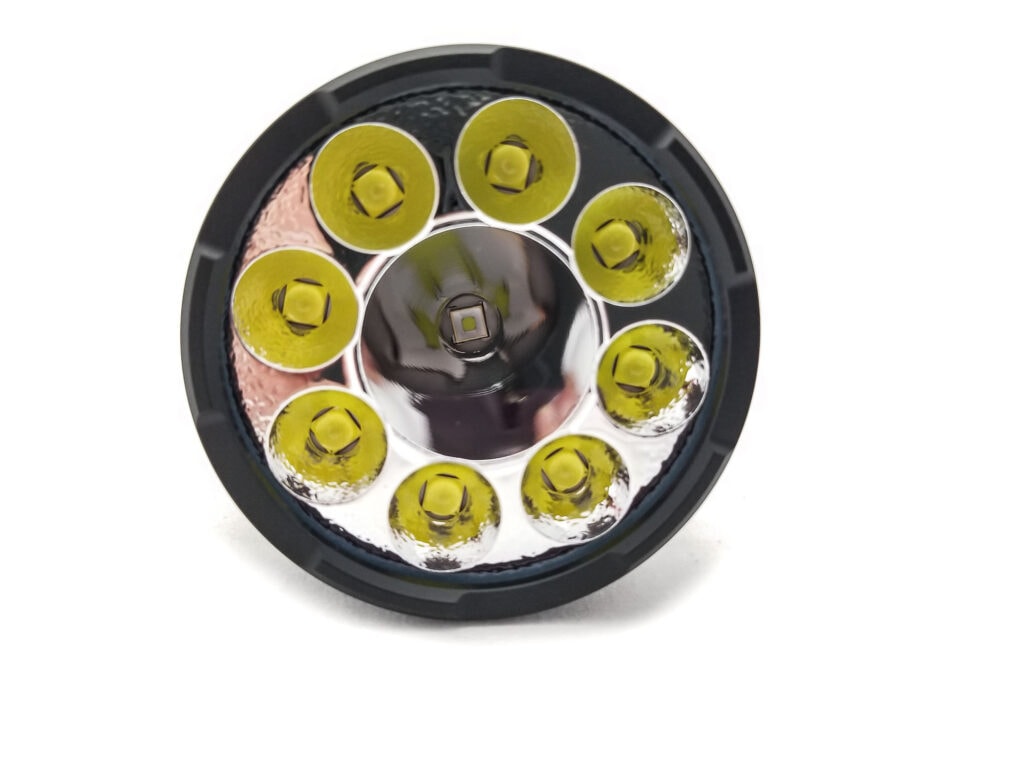
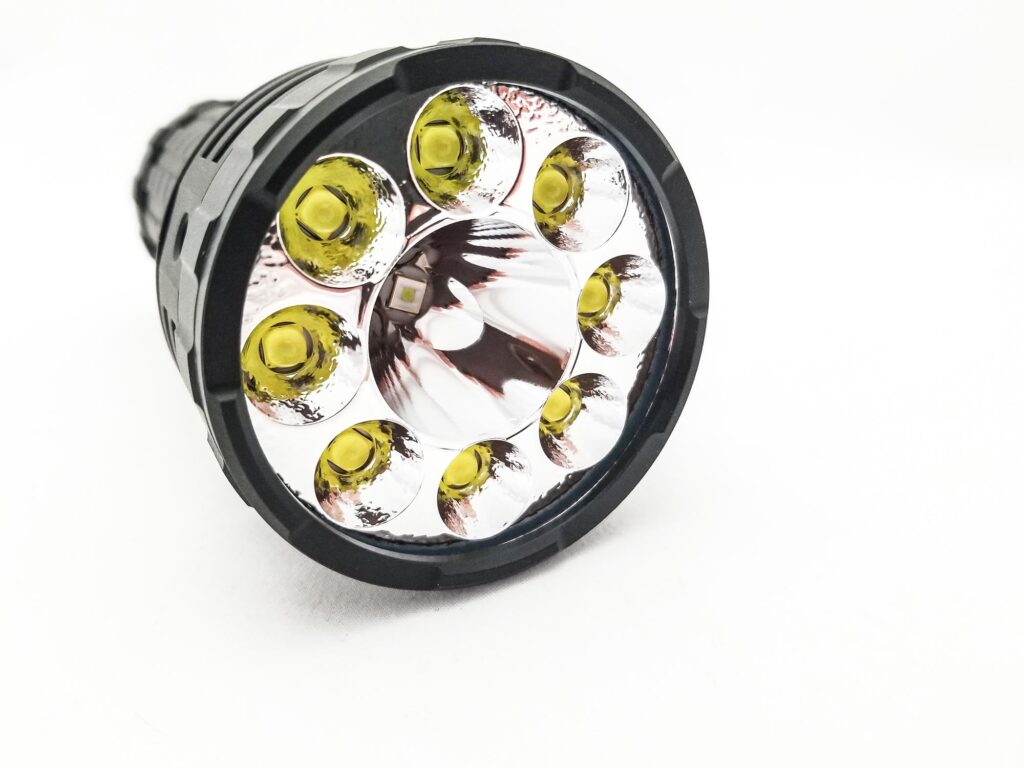
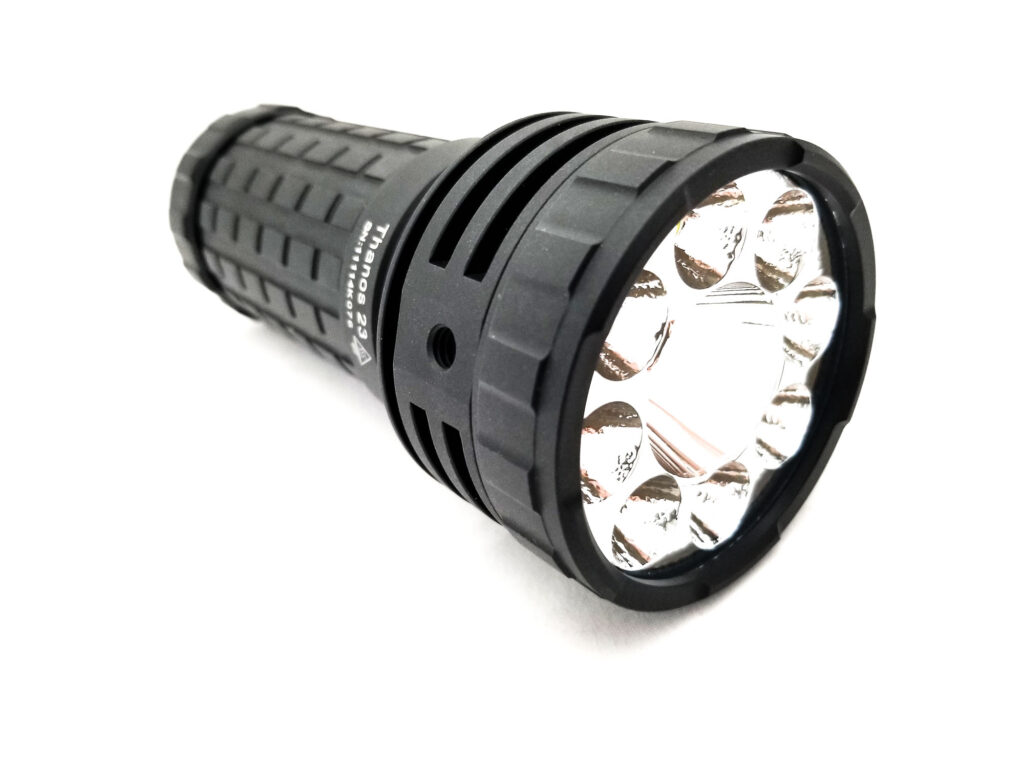

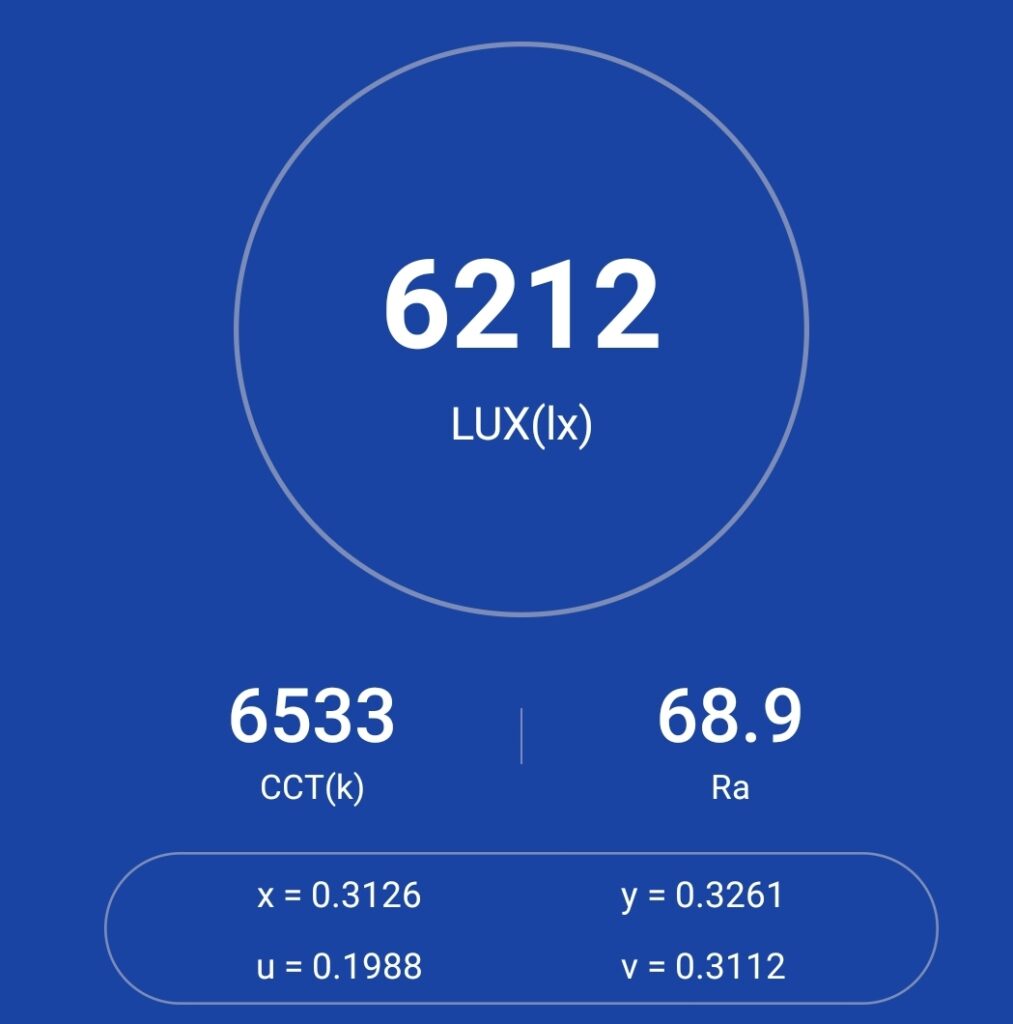
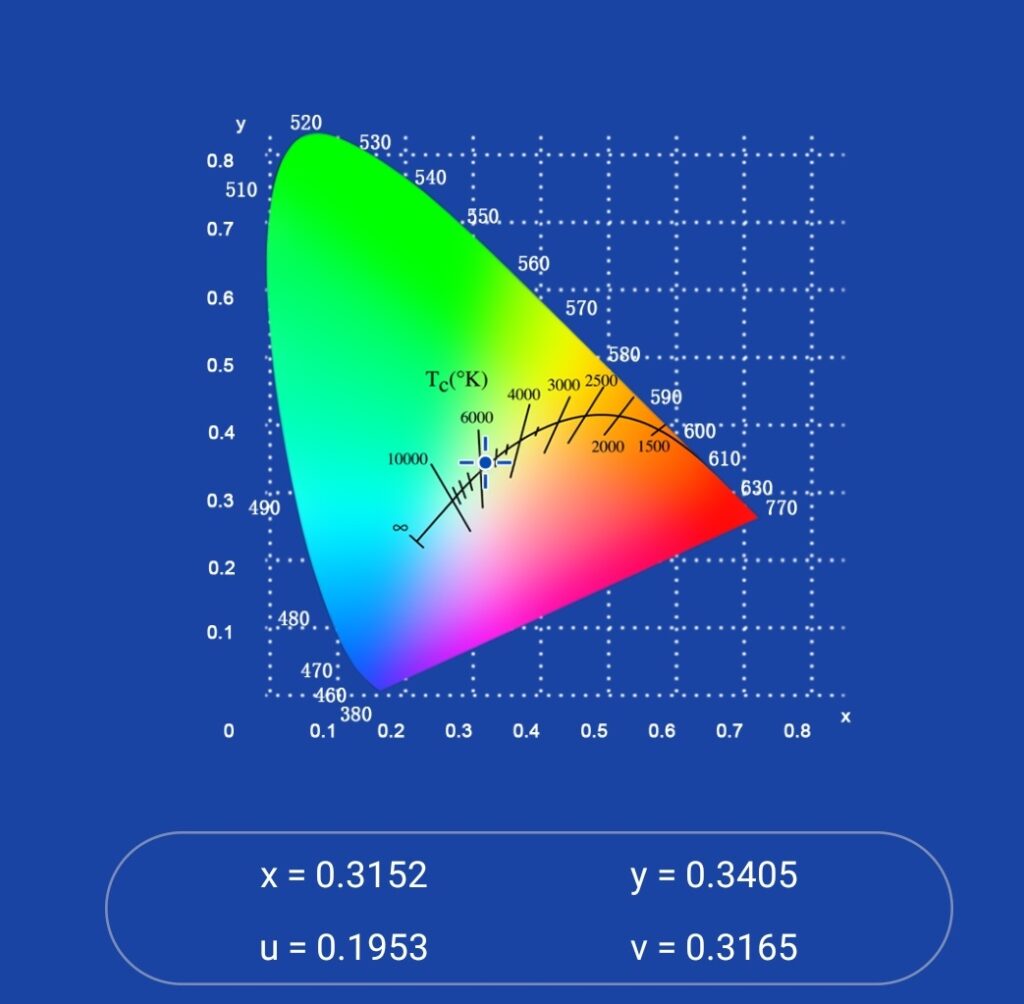

Dimensions and its competition
| Lumintop Thanos 23 | Millimeters | Inches |
|---|---|---|
| Length | 153 mm | 6 in |
| Head diameter | 68 mm | 2.7 in |
| Body diameter | 51 mm | 2 in |
Dimensions are rounded to the nearest millimeter, and to the nearest tenth of an Inch.
Weight:
| Lumintop Thanos 23 | Weight in grams | Weight in oz |
|---|---|---|
| Without batteries: | 522 g | 18 oz |
| With 3x 5000mAh batteries | 723 g | 25 oz |
Weight is rounded to the nearest gram, and to the nearest tenth of an Oz. For a chubby light, the Thanos isn’t overly cumbersome, and it’s relatively compact. That said, the Mach is much lighter owing to the active cooling reducing the amount of aluminum needed for heatsinking.
Flashlight size comparison with its competition:
Group 1 left to right, high power flashlights: Lumintop Mach, Lumintop Thanos 23, Thrunite TN50, Wurkkos TS32
Group 2 left to right: Lumintop D3, Thanos 23, Thorfire C8
Group 3 left to right: Lumintop Mach, Lumintop Thanos 23
Group 4 reflectors left to right: Lumintop Thanos 23, Wurkkos TS32
Group 5 reflectors left to right: Lumintop Thanos 23, Lumintop Mach

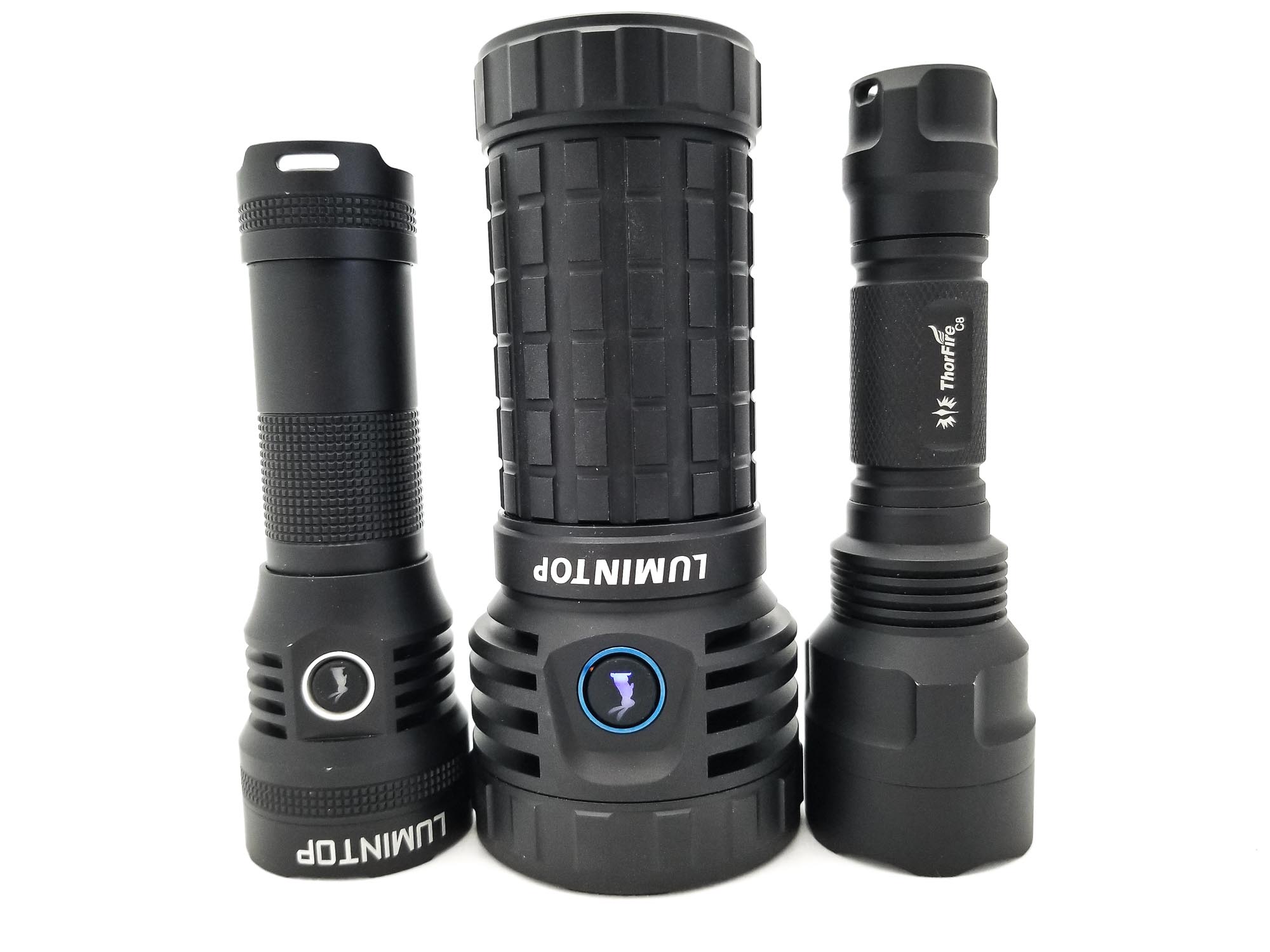
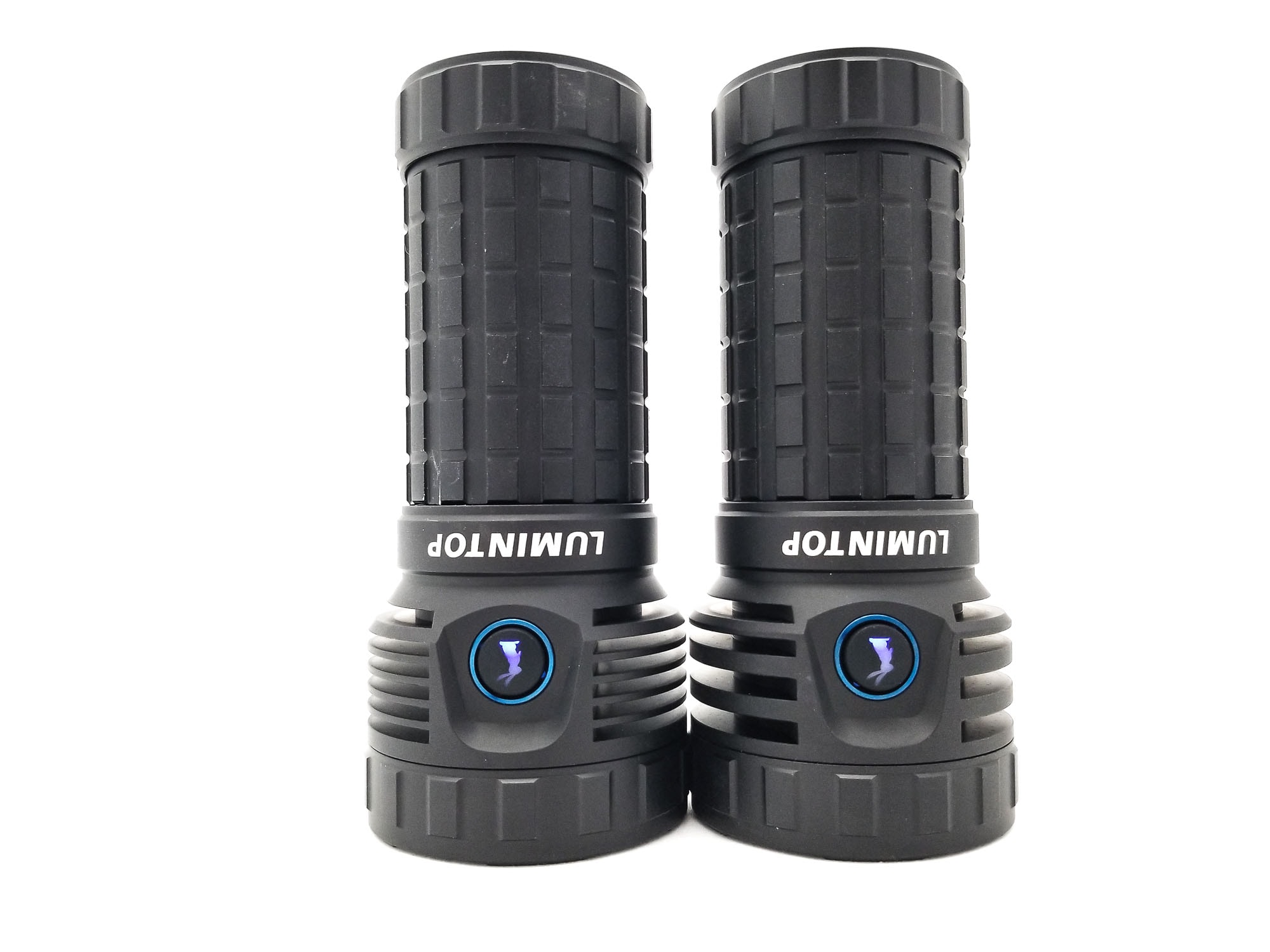

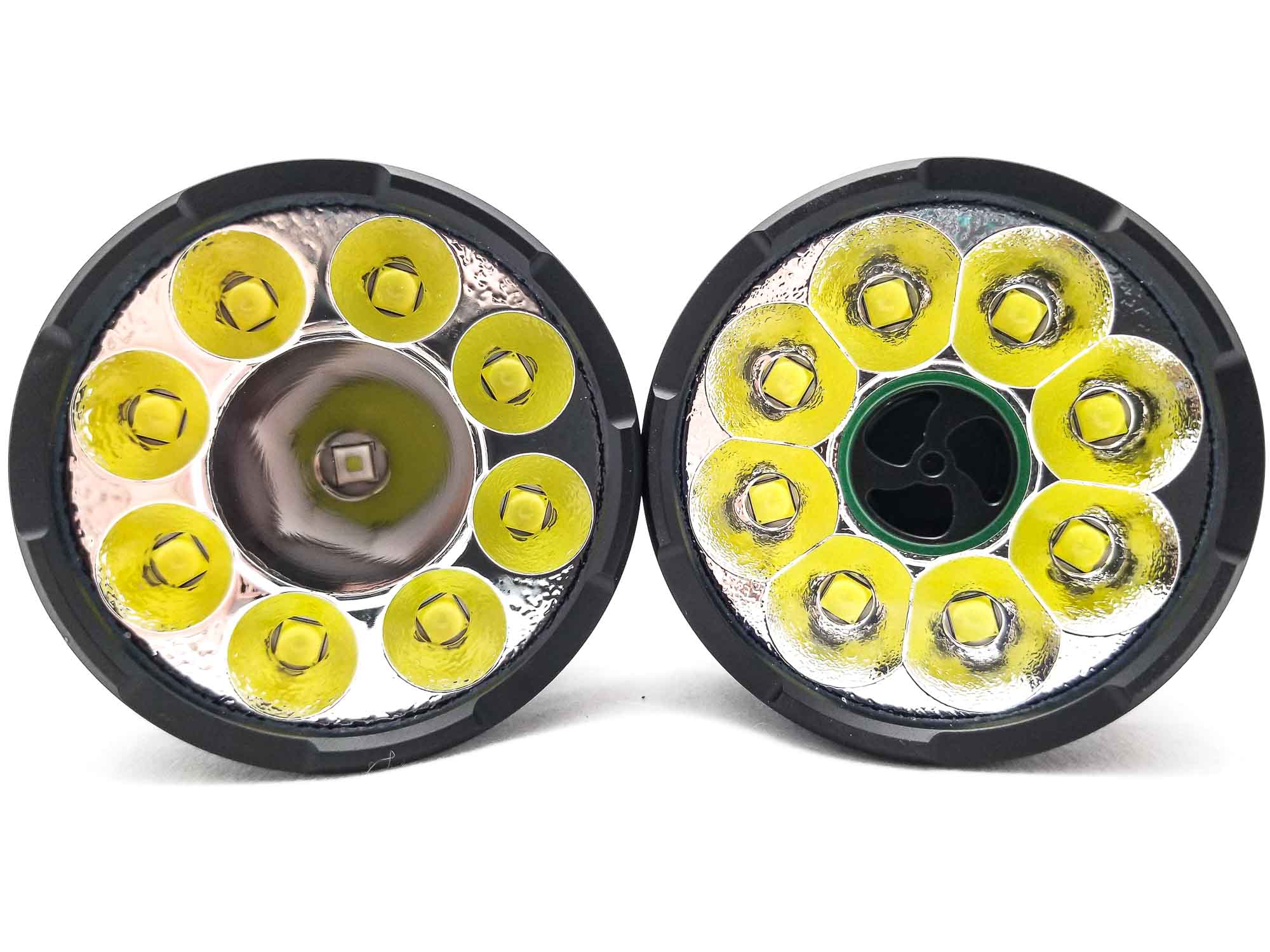
Lumintop Thanos 23 UI: User Interface and Driver
The driver is going to be a FET driver with a 7135 regulator for low and moonlight modes and a MOSFET controlled by PWM for direct drive. These drivers have a few advantages over a boost or buck driver, namely they’re cheap, easy to make, and can produce a lot of light. The disadvantage is the unregulated output, where the output drop tracks with the battery voltage drop. The UI follows the trend of other flashlight manufacturers, even those catering to the Anduril crowd of enthusiasts, by not flashing Anduril or Anduril 2. That’s right, like the Mach, the Thanos doesn’t have Anduril, and that’s totally fine with me since Lumintop did a good job here, and it’s a decent UI. This one has stepped ramping and incorporates Moon, plus blinkies, and adds niceties like batt check, and electronic lockout. Switching between the lighting modes is also pretty simple, but it’s a bit quirky. This UI also axes the High 2 of the Mach’s UI.
Available modes:
- Stepped modes Moonlight, Low, Medium, High, Turbo
Available blinky modes:
- Strobe, SOS, Beacon
From OFF:
- Press and hold: Moonlight
- Single click: Turns on in last memorized brightness level
- Double click: High (Turbo is not available from OFF, just ON)
- 3 fast clicks: Switches lighting modes (flood, spot, or both)
- 4 fast clicks: Battery check. Like Anduril, the light blinks out the battery voltage, e.g. three blinks, pause, then 8 blinks is 3.8 volts
- 7 fast clicks: Turns switch LED on or off
- Click, click, hold: Momentary Turbo
From ON:
- Press and hold: Switches from L-M-H-L, or H-M-L-H (depending on your click and hold sequence
- 1 click: Turns off
- Double click: Turbo
- Triple click: Switches lighting modes (flood, spot, or both)
Mode memory:
- Remembers last brightness level. Turbo and blinkies and Moon are not memorized.
Shortcuts:
- To Moon: From off, long press switch for 1 second
- To Turbo: Double click from ON
- To Strobe: In Moonlight, double click to activate Strobe. To cycle through SOS and Beacon, double click again for each mode
Low voltage warning:
- Sort of. The light will drop to a very low level when the batteries reach a certain low voltage (not specified in the manual). I did notice it took a long time for the light to shut off after the last step down to a very low output.
Strobe/blinkies
- In Moonlight mode, double click to activate Strobe mode. Double click again for SOS and Beacon
Lock-out mode:
- From off, click the switch 4 times to activate lockout. Momentary Moonlight mode will be available in lockout. To deactivate lockout, repeat the 4 clicks.
Switching Lighting Modes:
- To switch between floodlight, spotlight, or flood+spotlight, triple click in on or off. The switch LED will change color based on the lighting mode: Green is flood, blue is spot, and a dual green/blue is for both. Note that you can switch this on the fly, and it’s pretty intuitive. All the same modes are available for spot, flood, or both.
PWM
- Yes, fast PWM not visible to the naked eye
Additional/summary info on the UI:
- I really like the fact that more lights are eschewing Anduril and flashing more traditional, simpler UIs that regular folks would enjoy out of the box without resorting to Google for help. While Anduril does have some nice features, Luminitop retained several of those features. Anduril die-hards, fan boys and girls might miss the ability to tweak stuff, but for the rest of us, it’s not a big deal. In fact, I like how Lumintop retained the useful features of Anduril like switch backlight control, batt check, and electronic lockout.
- However, it’s not perfect. First off, the mode selection order changes based on how you press and release the switch. It goes L-M-H if starting from off. However, if you release and press and hold again, the mode order is reversed, so it goes H-M-L. Sort of like how smooth ramping works on Anduril (up or down). Also, Turbo is not available from off with a double click. The light must be on to access Turbo. Lastly, like how the Mach shows the fan on/off state, I really like how the button shows the lighting mode with the color combination. Kudos to Lumintop!
Lumintop Thanos 23 Charging and batteries
The Thanos 23 utilizes three 21700 cells in parallel. Per Lumintop, the Thanos 23 accepts 21700s up to 72 mm long, and button tops are required. There’s actually a plastic disk in the middle of the driver PCB where the positive end of the battery and negative (ground ring) for reverse polarity protection to keep from nuking the light since it probably has zero input protection. I recommend high drain batteries with at least a 35 amp CDR. You can use lower-output cells, but the output takes a huge hit.
For charging, the Thanos 23 uses the same charging layout from the Thor Pro and Mach. For charging, unscrew the tailcap to reveal two USB ports and a neat segmented LED information display. You get a type C and USB type A port, and both are bidirectional, meaning they can accept charge input and charge output as a power bank.
The type C port is PD 3.0 capable with adaptable output supporting 5v, 9 v and 12 volts up to 4 amps. The USB A port supports QC3.0, with up to 12 volts and 3 amps. The power bank can discharge at up to 5 V 3 A, or 15 watts. I plugged the Thanos 23 into a 45 watt PD power brick and on type C to type C it maxed out at about 12 v 1.4 amps and on a 18 watt QC3 charger I was getting about 8.9 volts and 2.09 amps on mostly discharged batteries. My USB tester shows 3 hours 28 minutes.
I plugged in some PD cable flashlights (the Lumintop D3 and Nightwatch SupernValkyrie) and the D3 charged at 9 volts 1.7 amps and the Valkyrie maxed out at 12 volts 1.43 amps before it dropped out due to overload. This is pretty good charging speed on the power bank. The batteries were 4.19 volts when fully charged.
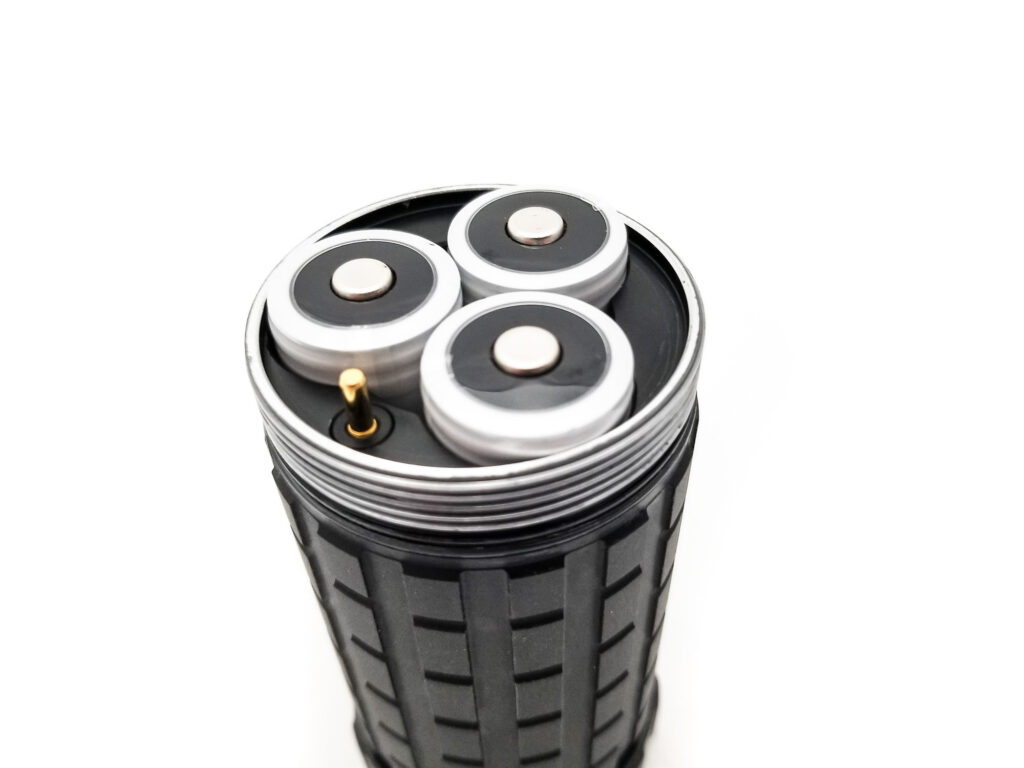

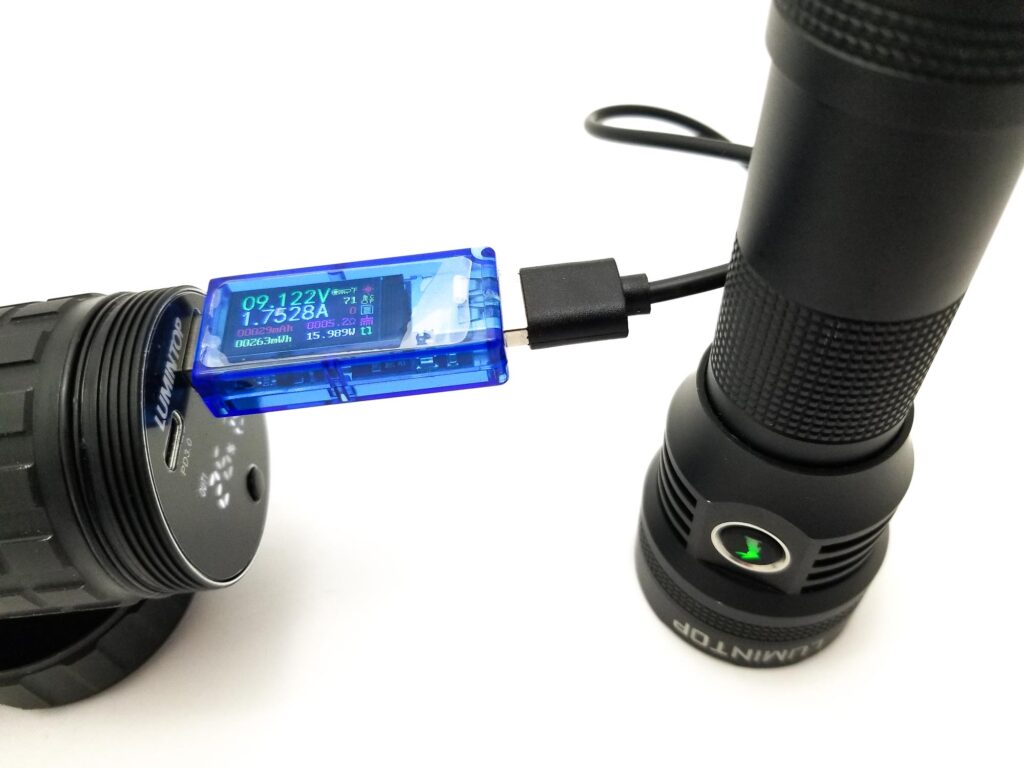

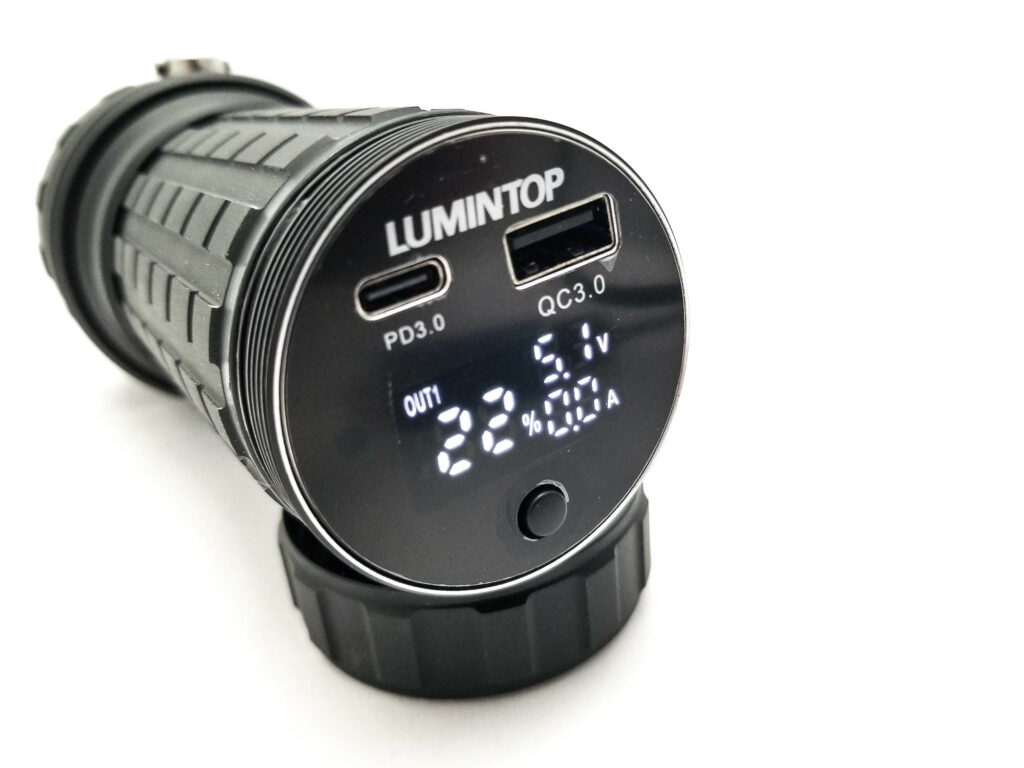

Performance test
Lumen measurements
How Lumens are Measured: Understanding ANSI FL1 Standards How Lumens are Measured: Understanding ANSI FL1 Standards: The ANSI FL1 standards specify that output in lumens should be measured 30 seconds after turning on, as this is the standardized time for measuring brightness according to the industry standard. This is why we focus on this part in our measurements. The ANSI FL1 standards require an ambient temperature of 22 ± 3°C. We record the ambient the ambient temperature to identify potential reasons for any observed discrepancies.Lumens are measured in my 50 cm integrating sphere with a Digi-Sense 20250-00 data logging luxmeter. The sphere has been calibrated with a Convoy S2+ measured to 260 Lumens and the figures are within 10% of actual. No current readings this time since measuring the current for soda can lights is both challenging and risky since accidentally shorting the input would release the magic smoke that makes electronics stop working. I used the included Lumintiop 5000 mAh batteries, fully charged, for the test.
Lumen measurements (for each mode)
| Mode | Specs | turn on | 30 sec | 10 minutes |
|---|---|---|---|---|
| Spotlight | ||||
| Moon | 1 | 1.2 lm | 1.2 lm | – |
| Low | 100 | 103 lm | 103 lm | – |
| Medium | 400 | 363 lm | 363 lm | – |
| High | 1200 | 996 lm | 984 lm | 332 lm |
| Turbo | 1800 | 1587 lm | 1243 lm | 344 lm |
| Floodlight | ||||
| Moon | 1 | 1.2 lm | 1.2 lm | – |
| Low | 450 | 467 lm | 467 lm | – |
| Medium | 1800 | 1648 lm | 1648 lm | – |
| High | 9000 | 7749 lm | 7503 lm | 1476 lm |
| Turbo | 26,000 | 21,033 lm | 13,407 lm | 1476 lm |
| Spotlight+Floodlight | ||||
| Moon | 2 | 1.2 lm | 2.4 lm | – |
| Low | 500 | 529 lm | 529 lm | – |
| Medium | 2000 | 1894 lm | 1894 lm | – |
| High | 10,000 | 7872 lm | 7872 lm | – |
| Turbo | 27,000 | 22,017 lm | 12,300 lm | 1722 lm |
Parasitic drain:
- Not tested
While I didn’t see the output specs, this is still really good (albeit brief) output, and a lot better than an Anduril/Anduril 2 light could do even when set to 55 C. There’s a good amount of thermal mass here and a good thermal path at work. The Moon modes really are pretty low for a big light.
Lumintop Thanos 23 Battery Life: Runtime graphs
How Runtimes are Measured: Understanding ANSI FL1 Standards About ANSI FL1 runtime standards: The runtime is measured until the light drops to 10% of its initial output (30 seconds after turning on). This does not mean that the flashlight is not usable anymore. The last column shows how long the light actually works till it shuts off. If there is a + symbol, it means that the test was stopped at that particular point, but the light was actually still running. This happens on certain occasions, with certain drivers, firmware, or batteries.Runtimes are measured in my 50 cm integrating sphere with a Digi-Sense 20250-00 data logging luxmeter. The sphere has been calibrated with a Convoy S2+ measured to 260 Lumens and the figures are within 10% of actual. I measure temperature readings with my Digi-Sense 20250-92 data logging thermocouple. The thermocouple is affixed to the head with kapton tape, and I used the same 5 second sampling rate as the luxmeter. I used the included 5000 mAh 21700s, fully charged, for the test.
| Mode | Specified runtime | Measured runtime ANSI | Time till shut off |
|---|---|---|---|
| Spotlight | |||
| High | 60s+12hr | 11h 6m | 11h 6m+ |
| Turbo | 20s+12hr | 10h 74m | 12h 47m |
| Floodlight | |||
| High | 60s+4hr | 2h 50m | 4h 5m |
| Turbo | 20s+4hr | 40s | 3h 57m |
| Spot+Floodlight | |||
| Turbo | 20s+3h 30 | 45s | 3h 15m |
My runtimes mostly track with Lumintops figures. As expected, the ANSI runtimes for the Turbo modes (especially floodlight) are extremely abbreviated, measured in minutes and seconds. I won’t knock the Thor 23 here too much since Lumintiop doesn’t make claims to high sustained output. The High spotlight mode ran for a long time. I ended the test after 11 hours since it was still going strong. I have no doubt it would have run much longer. The heating is very fast on Turbo(s) for the flood and flood+spotlight, up to over 40 C in less than 70 seconds. I measured the temperatures for under 4 hours since that gets a bit monotonous once the output levels off. Even though this isn’t a regulated driver, the output is still decent. The light is still useable at low output after each test. The batteries read 2.8 to 3.0 volts after the tests.

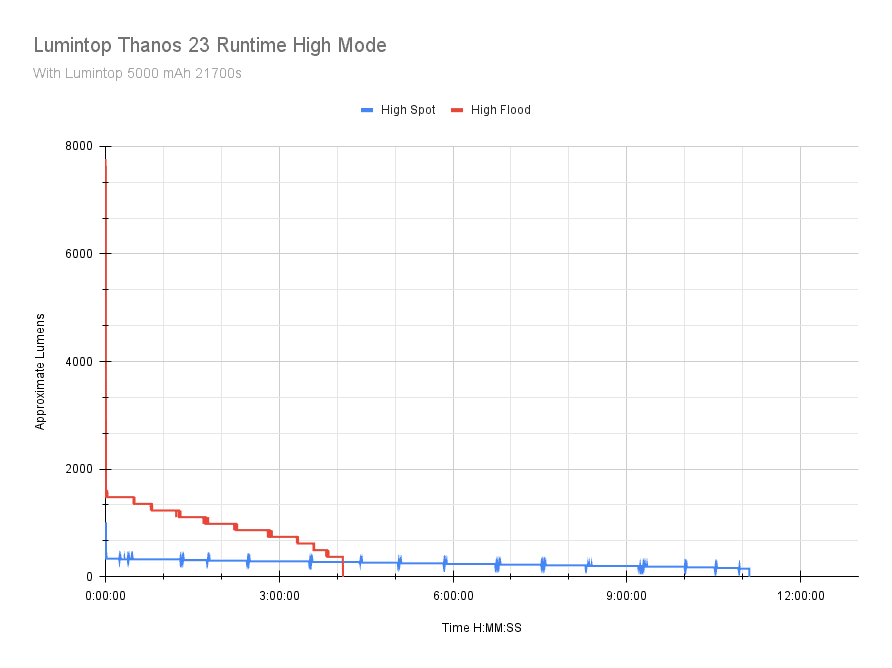

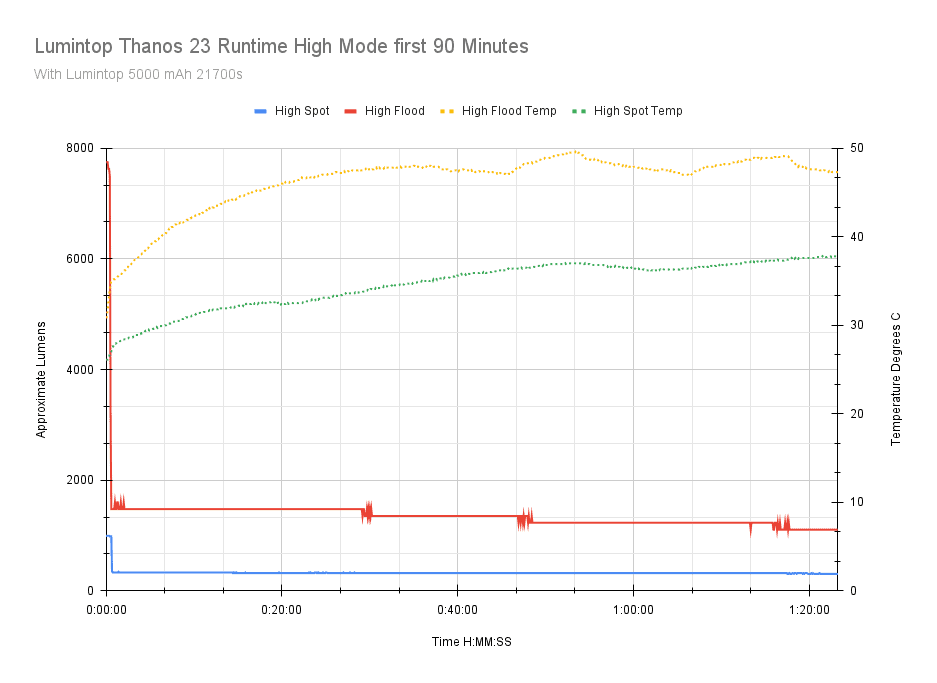
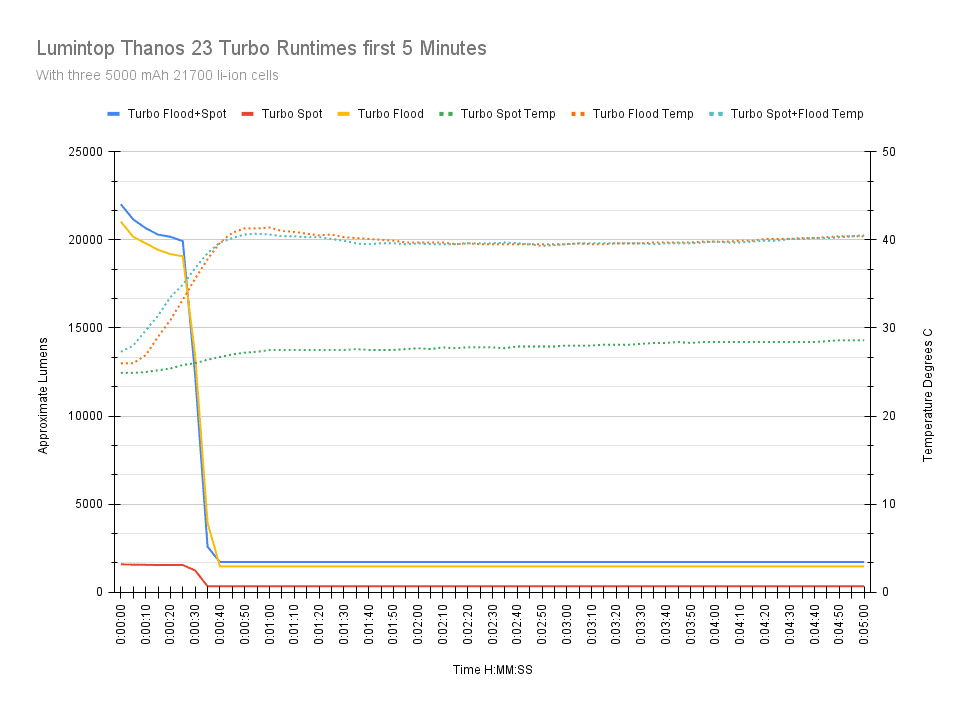
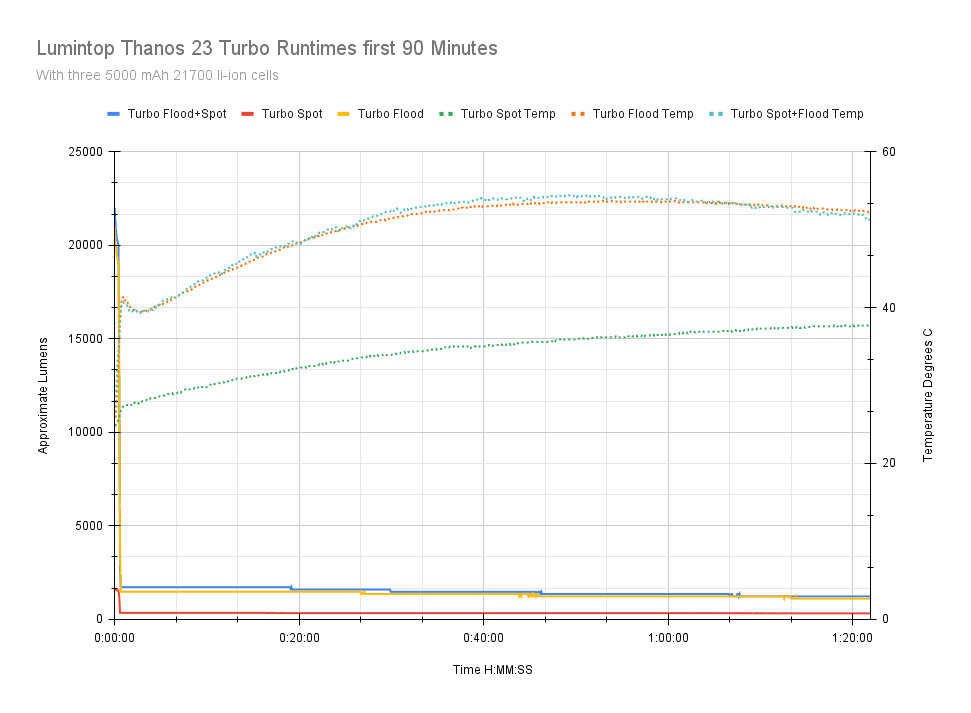
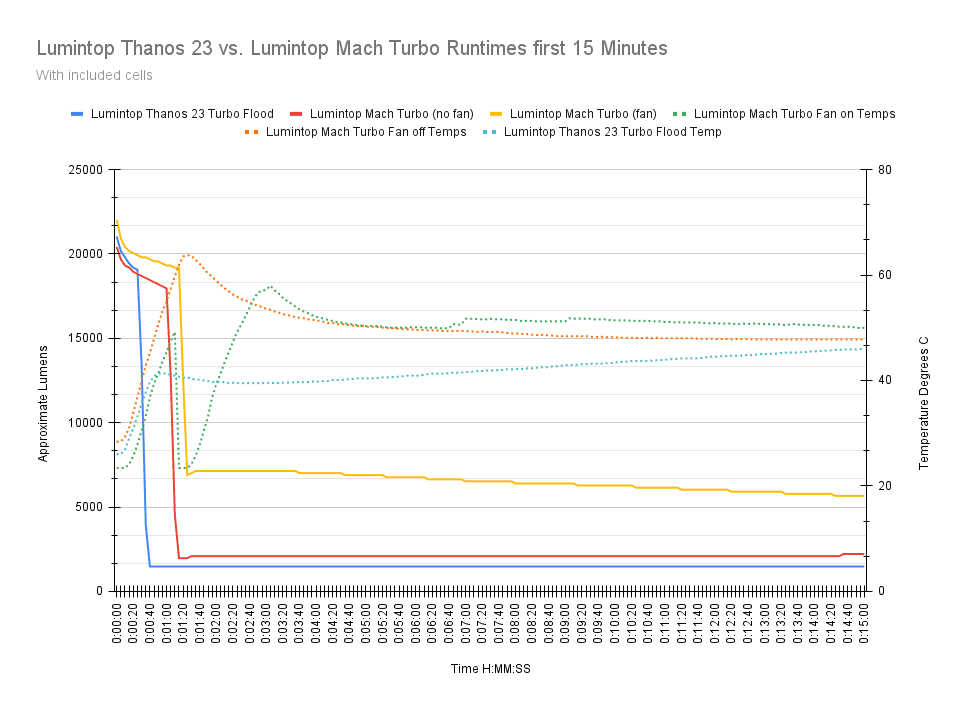
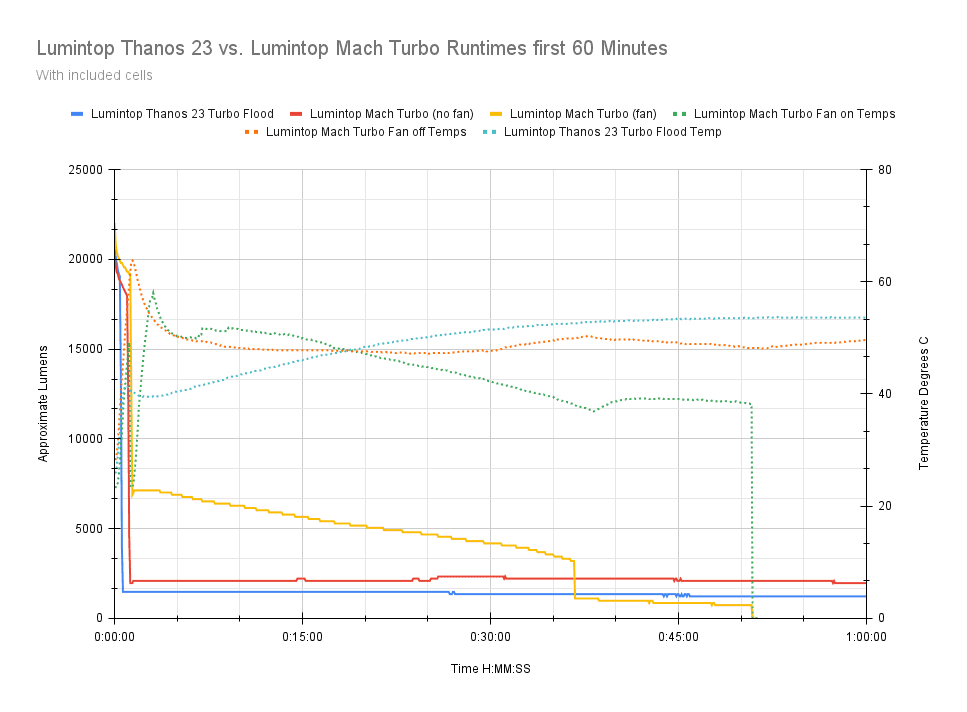

Peak beam intensity and beam distance measurements
About Peak beam intensity: Understanding ANSI FL1 Standards About peak beam intensity The calculated value of distance in meters at which the flashlight produces a light intensity of 0.25 lux. (0.25 lux is about the brightness of a full moon shining on an object). This means that the intensity has decreased so much, it becomes difficult to see darker objects, or objects that don’t reflect light. The columns ‘Meters’ and ‘Yards’ use rounded numbers.The beam distance test was conducted using the Uni-t UT383S luxmeter at a distance of 5 meters. I used the included 5000 mAh batteries, fully charged, for the test. Measurements taken at 30 seconds per ANSI spec.
| Mode | Specs | Candela measured | Meters | Yards |
|---|---|---|---|---|
| Spotlight | ||||
| Moon | ? | 50 | 14 | 15 |
| Low | ? | 6350 | 159 | 174 |
| Medium | ? | 21,500 | 293 | 320 |
| High | ? | 40,675 | 403 | 441 |
| Turbo | 90,000 | 94,500 cd | 615 | 673 |
| Floodlight | ||||
| Moon | ? | N/A | N/A | N/A |
| Low | ? | 1425 | 75 | 82 |
| Medium | ? | 5500 | 148 | 162 |
| High | ? | 24,625 | 314 | 343 |
| Turbo | 62,500 | 46,750 cd | 432 | 472 |
| Turbo at Start | ? | 63,000 | 502 | 549 |
| Spot+floodlight | ||||
| Moon | ? | 75 | 17 | 19 |
| Low | ? | 6525 | 162 | 177 |
| Medium | ? | 24,000 | 310 | 339 |
| High | ? | 64,600 | 508 | 556 |
| Turbo | 125,000 | 29,850 cd | 346 | 378 |
| Turbo at Start | ? | 134,750 d | 734 | 803 |
Lots of throw figures here! Overall advertised specs are tracking pretty close on the ANSI figure, but only at startup. The output is dropping rapidly by the 30 second mark due to heating and battery sag on Turbo, which is the only candela figure Lumintop advertised. This is good performance on all the lighting modes, lots of throw or flood pretty pretty much on demand.
Beamshots
Photos taken with my Samsung Note 8 set to 0.3s ISO 200 and 5000K WB. The fence is 40 meters distant. You can see the difference in the different LEDs and reflector configurations.
Beamshots of the following flashlights compared:
- Lumintop Thanos 23
- Thrunite TN50
- Lumintiop Mach
- Wurkkos TS32
- Nightwatch NS14
- Nightwatch NS59v1
- Amutorch DM80
- Haikelite HT90
- Haikelite HK90
- Fenix LR80R
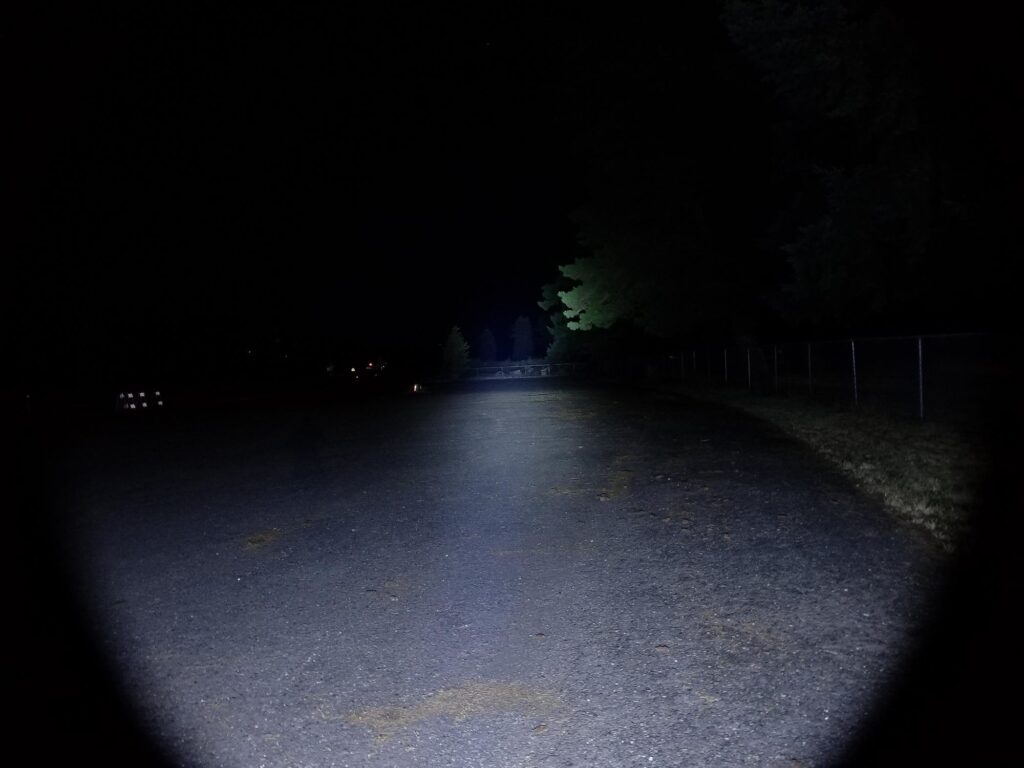











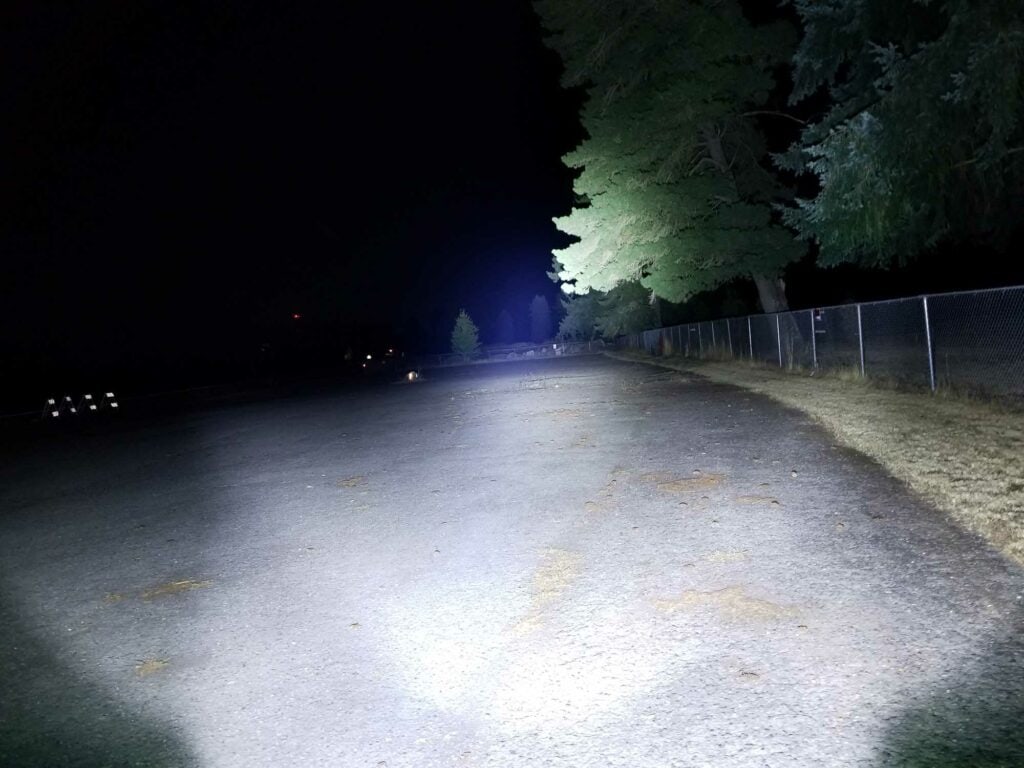

Disclaimer: This flashlight was sent to me for review at no cost by Flashlight GO. I have not been paid to review, nor have I been holding back on problems or defects.
Final Verdict
Pros
- Great build quality
- High output
- Versatile throw/flood capabilities
- Simple and intuitive UI (no Anduril!)
- Super handy USB type C charging with power bank output
Cons
- Unregulated driver
- Turbo modes are short-lived
- Didn’t meet output specs
- Mediocre sustained output
Explanation on star ratings:
1: Avoid: a match would be a better choice – 2: Poor: significant defect or issues; almost unusable – 3: Average: some defects or issues; but still usable 4: Good: recommended (minor issues) – 5: Great: highly recommended

4 stars: ★★★★
While our star rating provides a reliable indicator, we encourage you to read the full review to make an informed decision based on your own needs and preferences.
Fresh off my endeavor with the Mach, the Thanos 23 bore some marked similarities (hey’re almost the same host) with the identical battery and charging layout, identical battery tube design, except the Mach was actively cooled, and the Thanos is passively cooled. In the Thanos, the fan was swapped out for a reflector and throwy LED. Yah, it makes a difference to have the fan! I really enjoyed my time with the Thanos 23. It’s a versatile, very high output flashlight that would be good in a variety of use-cases. I’m glad the power bank was carried over, and the floodlight beam with the XHP50.2s isn’t bad.
Having the throw channel was also nice, and I was chuffed to bits that you can independently control the lighting sources/modes on the fly. I’m not at all bummed that Anduril is not present either, as I think Lumintop got the UI right (although I don’t like the stepped mode memory nonsense L-M-H-H-M-L). It is a bit spendy as well, but these type of lights aren’t cheap anyways.
While the output looks good, it doesn’t quite meet Lumintop’s specs, and the sustained output isn’t great for a high output light. Still, lots of output to be had here. Compared to the Wurkkos TS32, the Thanos has higher output, better sustained output as well (although I do like the beautiful tint of the TS32).
Aside from being super surprised that Lumintop hasn’t been visited (that I know of) by the Marvel Studios legal representatives for ‘borrowing’ the Thanos name, I do know they’ve made another very capable and functional very high output flashlight. It’s not the Mach, but if quiet is your thing, and you’re not apt to join the fan club, the Thanos 23 just might fit the bill and that gets it 4 stars.
Buy your Lumintop Thanos 23 with a discount
Get 15% off with the following code: 1lumen15
Get 10% off all flashlights at FlashlightGo with our exclusive discount coupon: 1lumen
1lumen selects and reviews products personally. We may earn affiliate commissions through our links, which help support our testing.